Physical Address
304 North Cardinal St.
Dorchester Center, MA 02124
Most diseases are influenced by environmental factors, and some are directly caused by environmental insults. Broadly defined, the ambient environment encompasses the various outdoor, indoor, and occupational settings in which humans live and work. In each of these settings, the air people breathe, the food and water they consume, the toxic agents they are exposed to, and the stresses they encounter are major determinants of health. Other environmental factors pertain to the individual (“personal environment”) and include tobacco use, alcohol ingestion, therapeutic and nontherapeutic drug consumption, and diet. Many of these personal factors are related to gender, class, and socially defined race.
The term environmental disease refers to disorders caused by exposure to chemical or physical agents in the ambient, workplace, and personal environments, including diseases of nutritional origin. Environmental diseases are very common: the International Labor Organization has estimated that work-related injuries and illnesses kill more people per year globally than do road accidents and wars combined. Most of these work-related problems are caused by illnesses rather than accidents. The burden of disease in the general population created by nonoccupational exposures to toxic agents is more difficult to estimate, mostly because of the diversity of agents and difficulties in measuring the dose and duration of exposures. Whatever the precise numbers, environmental diseases are major causes of disability and suffering and constitute a heavy financial burden, particularly in lower-income countries.
Environmental diseases are sometimes the consequence of major disasters, such as the methyl mercury contamination of Minamata Bay in Japan in the 1960s and lead poisoning resulting from contaminated drinking water in the city of Flint, Michigan, in the United States in 2016. Less dramatic, but much more common, are disease and injury produced by chronic exposure to relatively low levels of contaminants. Disease related to nutrition is even more pervasive. In 2014 it was estimated that globally 462 million adults were underweight and 1.9 billion were either overweight or obese. Children are disproportionately affected by undernutrition: in 2016 an estimated 155 million children worldwide under the age of 5 years showed low height for age (stunting), a finding associated with chronic or recurrent undernutrition.
Health disparities in the United States are increasingly linked to social, cultural, and economic factors that include income, education, and occupation as well as variables that are more challenging to measure such as medical literacy, generational wealth, access to healthcare, food availability, living environment, and racial bias.
In this chapter, we first consider the problem of health disparities. We then discuss the issue of climate change followed by a section on the mechanisms of toxicity of chemical and physical agents and finally address specific environmental disorders, including those of nutritional origin.
Health disparities are the differences in the incidence, prevalence, and severity of diseases between populations. Disparities may occur between groups based upon various attributes of an individual's identity, including gender, class, and socially defined race. Racism is a deeply rooted and ongoing feature of modern societies, so a clear understanding of the concept of “race” is critical in any discussion of health disparities. In the 19th century, different naturalists argued that there were anywhere from 2 to 63 human biological races, a state of confusion that reflected an inability to agree on the characteristics that should define race. The difficulty of dividing human populations into specific biological races was brought into focus when scientists began using genetics to examine human biological diversity. In the 1960s it was recognized that groups formerly considered distinct races (e.g., Africans, Asians, and Europeans) could not be differentiated based on the frequency of genetic polymorphisms. In recent years, this finding has been reinforced by various international DNA sequencing projects, which have produced data that invalidate the idea that there are distinct human biological races. The modern biological conception of race is defined by two criteria: (1) the amount of genetic variation within such groups compared to that between them and (2) whether any group within a species can be shown to be an evolutionarily distinct population. Studies of human populations have shown greater genetic variation within populations (e.g., African, East Asian, European) than between populations, leading to the conclusion that because of high levels of gene flow between populations, no population is truly genetically distinct. Furthermore, while geographically based genetic variation exists within our species, there is no unambiguous way to partition that genetic variation into groups, because human genetic variation is continuous, not discrete. Based on these considerations, the consensus position of modern population geneticists and biological anthropologists is that there are no biologically distinct races in modern humans.
However, throughout history, societies have distinguished certain populations based on arbitrary criteria such as appearance and geographic origin. This resulted in individuals being assigned to socially defined races, which continue to serve as the basis for social dominance in nations around the world. Social subordination results in groups being more likely to be exposed to environmental variables that have a negative impact on their health, such as air and water pollution, crowding, poor diet, inadequate education, greater exposure to toxic chemicals, lack of access to health care and infectious disease. When compared to European Americans, African Americans have increased infant mortality (more than 2-fold), prostate cancer mortality (2.5-fold), and COVID-19 mortality (nearly 2-fold). Type 2 diabetes, hypertension, and obesity are also more common in this population. The United States Latin American population also has increased rates of type 2 diabetes and obesity. Rates of health insurance coverage vary by socially defined race, which contributes to these disparities: according to CDC data, U.S. Latin American adults are least likely to have health insurance, whereas Asian Americans and European Americans are most likely.
While population-specific genetic differences do exist, socially defined race does not accurately reflect this genetic variability. Ethnicity, which is defined as group identity based on multiple characteristics including culture, country of origin, language and religion, can also influence health outcomes. In the United States, ethnicity is usually dichotomized as Hispanic or non-Hispanic. The term “Hispanic” in the U.S. census and many research studies refers to Americans of Spanish origin or descent, whereas “Latin American” includes non-Spanish speaking populations (e.g., Brazilians) of Central and South America with varying amounts of African, Amerindian, and European ancestry.
Historically, descriptors of socially defined race have included skin pigmentation (e.g., white, black), references to origin (African American, Asian American), and archaic 18th century anthropological terms such as “Caucasian”; in this textbook, we will use terms related to geographic origin for socially defined race: European American, African American, etc. Associations related to genetic disorders that are more prevalent in certain populations (e.g., cystic fibrosis) are best considered within the framework of geographic ancestry such as “of European descent.” This approach is useful but imperfect due to (1) gene flow between populations (population admixture) and (2) historic associations of diseases with socially defined races or countries (e.g., “African American” or “Indian”) that do not fully reflect the distribution of causative genetic variants across population. For example, sickle cell disease is commonly associated with African Americans; however, the basis for this association is positive selection for an allele that offers protection wherever falciparum malaria is found, including equatorial Africa, Southern Europe, the Middle East, and parts of Asia.
Thus, while racial and ethnic associations with disease are commonly stated in the medical literature, care must be taken in interpreting these relationships since they are not the result of inherent biological differences. Furthermore, while there may be statistically significant differences in disease incidence between socially defined races, the clinical relevance of these disparities is not always clear in rare diseases. Health disparities also reflect associations with socioeconomic status, geography, occupation, gender identity, and sexual orientation. Awareness of the issues that contribute to health disparities continues to increase, and an understanding of the social determinants of health and their impact on an individual's health is critical for the future health professional.
Without immediate action, climate change stands to become the preeminent global cause of environmental disease in the 21st century and beyond ( Fig. 7.1 ). Global temperature measurements show that the Earth has warmed significantly since the early 20th century and especially since the mid-1960s. Record-breaking global temperatures have become common, and the 5 years from 2016 to 2020 were the warmest since record keeping began in 1880. During 2020 the global land temperature was 1.59°C warmer than the 20th century average. Mean global ocean temperatures also continue to rise.

The rising atmospheric and oceanic temperatures have led to a large number of effects that include changes in storm frequency, drought, and flood, as well as large-scale ice losses in glaciated regions and dramatic reduction in the amount of sea ice in the Arctic Ocean. The melting of land-based glacial ice and the thermal expansion of the warming oceans have produced approximately 13 to 20 cm of global average sea level rise since 1900, and the sea level is currently rising at a global average rate of 3.6 mm/year.
Scientists have conclusively demonstrated that climate change is due to human activity through rising atmospheric level of “greenhouse” gases, particularly carbon dioxide (CO 2 ) released by the burning of fossil fuels ( Fig. 7.2 ), ozone (an important air pollutant, discussed later), and methane. These gases, along with water vapor, produce the so-called greenhouse effect by absorbing energy radiated from Earth’s surface that would otherwise be lost into space. Deforestation and the attendant decrease in carbon fixation by plants also increase CO 2 levels. Depending on the computer model used, the global temperature is projected to rise by 2°C to 5°C by the year 2100 ( Fig. 7.3 ).
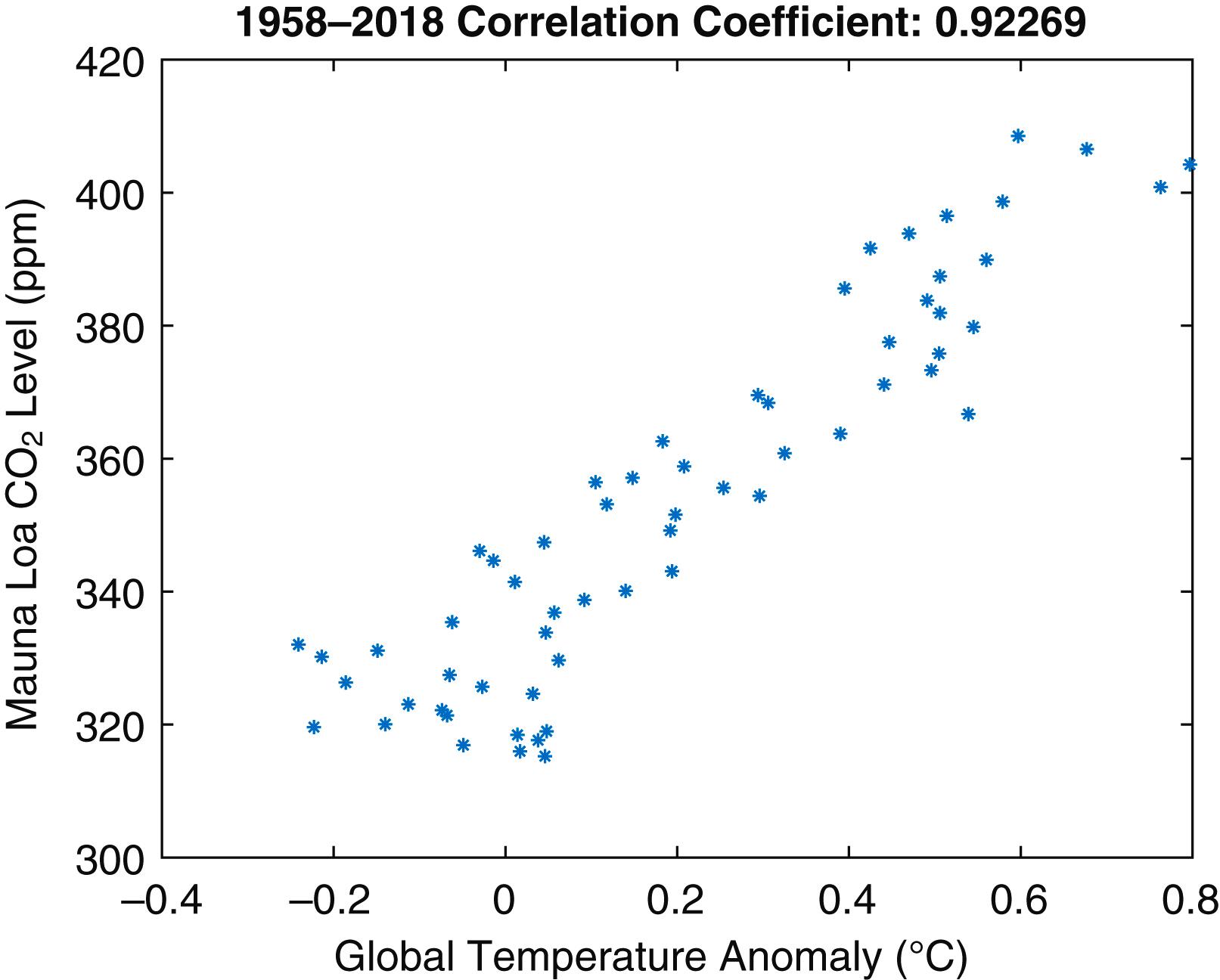
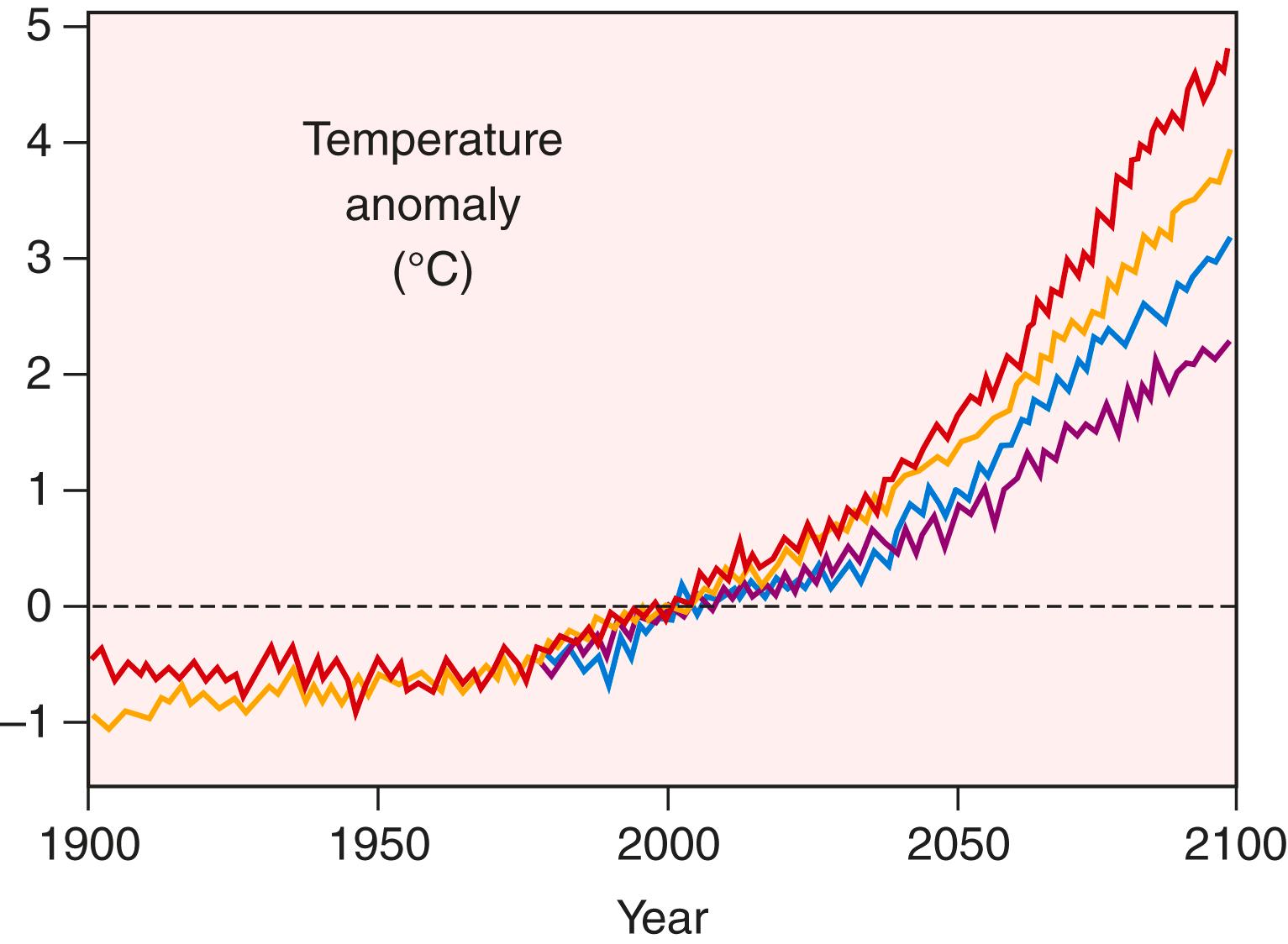
The health consequences of climate change will depend on its extent and rapidity, the severity of the ensuing consequences, and humankind’s ability to mitigate the damaging effects. The World Health Organization (WHO) estimates that approximately 250,000 excess deaths will occur annually between 2030 and 2050 because of climate change, a toll that does not include morbidity and disruption of health services due to extreme changes in weather. Because of residential segregation, those most severely affected will include individuals of low socioeconomic status and those living in racially subordinated communities, as was the case when Hurricane Katrina struck New Orleans in 2005.
Climate change is expected to have a serious negative impact on human health by increasing the incidence and severity of many diseases, including the following:
Cardiovascular, cerebrovascular, and respiratory diseases, all of which will be exacerbated by heat waves and air pollution
Gastroenteritis, cholera, and other foodborne and waterborne infectious diseases, caused by contamination of water supplies and disruption of sewage treatment due to floods and other environmental disasters
Vector-borne infectious diseases such as malaria and dengue fever, worsened by changes in the prevalence and geographic distribution of vectors due to increased temperatures, crop failures, and extreme weather variation
Malnutrition, caused by changes in local climate that disrupt crop production. Such changes are anticipated to be most severe in tropical locations, in which average temperatures may already be near or above crop tolerance levels; it is estimated that by 2080, agricultural productivity may decline by 10% to 25% in some lower-income countries as a consequence of climate change.
Beyond these disease-specific effects, it is estimated that the melting of glacial ice combined with the thermal expansion of warming oceans will raise sea levels by 2 to 6 feet by 2100. Approximately 10% of the world’s population—roughly 600 million people—live in low-lying areas that are at risk for flooding. It is estimated that some countries such as the Maldives will be completely submerged and hence cease to exist. The resulting displacement of people will disrupt lives and commerce, creating conditions ripe for political unrest, war, and poverty—the “vectors” of malnutrition, sickness, and death.
Toxicology is defined as the science of poisons. It studies the distribution, effects, and mechanisms of action of toxic agents. More broadly, it also includes the study of the effects of physical agents such as radiation and heat. In general, little is known about the potential health effects of chemicals. Of the approximately 100,000 chemicals in use in the United States, less than 1% have been tested experimentally for health effects. Furthermore, much of the testing to date is scientifically inadequate to determine long-term health effects. This is further complicated by the complex interaction between various pollutants and the age, genetic predisposition, and different tissue sensitivities of exposed persons. Thus, there are wide variations in individual sensitivity to toxic agents, limiting the value of establishing “safe levels” for entire populations.
We now consider general principles regarding the toxicity of exogenous chemicals and drugs.
The definition of a poison is not straightforward. It is a quantitative concept strictly dependent on dosage. The quote from Paracelsus in the 16th century that “all substances are poisons; the right dosage differentiates a poison from a remedy” is perhaps even more valid today, in view of the proliferation of therapeutic drugs with potentially harmful effects.
Xenobiotics are exogenous chemicals in the environment that may be absorbed by the body through inhalation, ingestion, or skin contact ( Fig. 7.4 ).
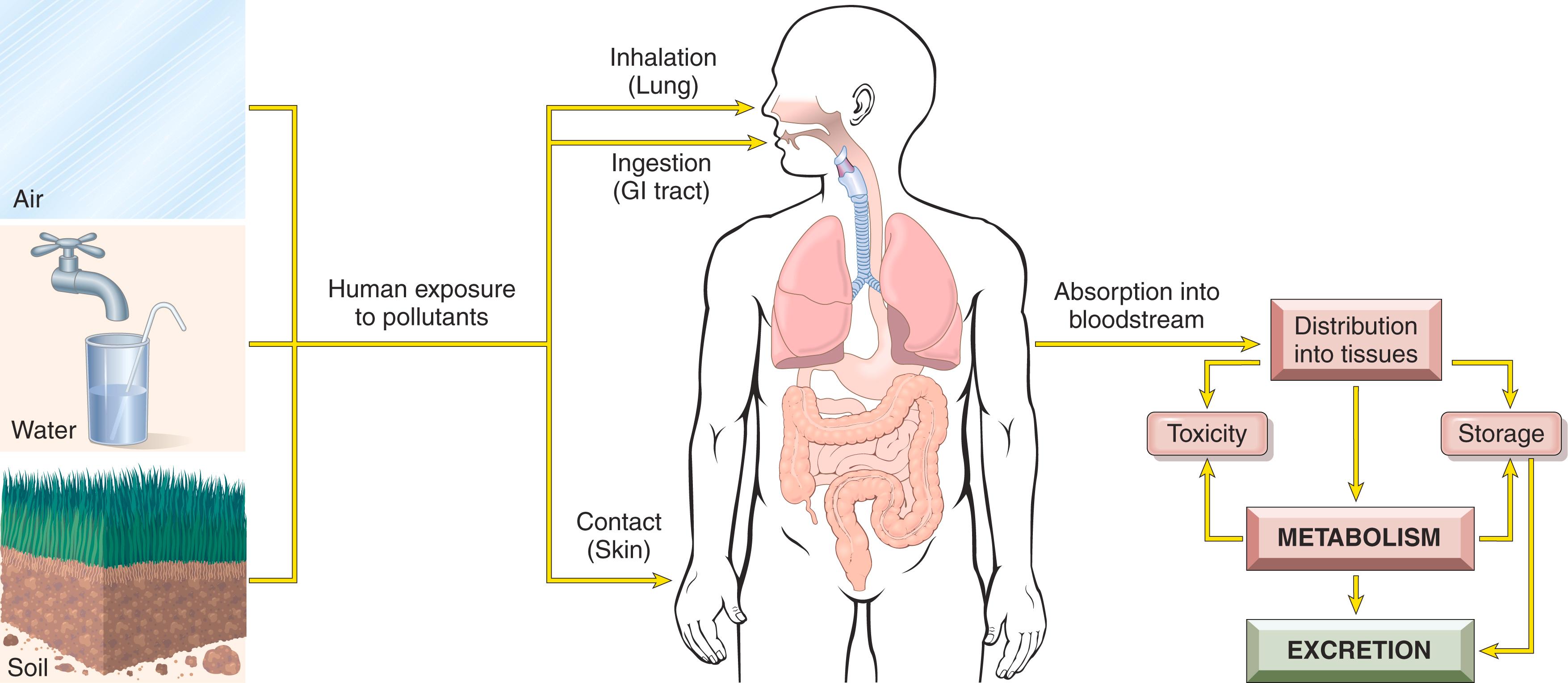
Chemicals may act at the site of entry, or they may be transported to other sites. Some agents are not modified on entry in the body, but most solvents and drugs are metabolized to form water-soluble products (detoxification) or can be activated to form toxic metabolites. Most solvents and drugs are lipophilic, which facilitates their transport in the blood by lipoproteins and penetration through lipid components of cell membranes.
The cytochrome P-450 system is the most important cellular enzyme system involved in reactions that either detoxify xenobiotics or, less commonly, convert xenobiotics into active compounds that cause cellular injury. Both types of reactions may produce reactive oxygen species (ROS) that can cause cellular damage ( Chapter 1 ). The P-450 system is present in organs throughout the body, but it is most active in the endoplasmic reticulum (ER) of the liver. Examples of metabolic activation of chemicals through the P-450 system include the conversion of carbon tetrachloride to the toxic trichloromethyl free radical and the generation of a carcinogenic DNA-binding metabolite from benzo[a]pyrene, present in cigarette smoke. The cytochrome P-450 system also participates in the metabolism of many common therapeutic drugs such as acetaminophen, barbiturates, and warfarin, and in alcohol metabolism (discussed later).
P-450 enzymes vary widely in activity among different people, due to both polymorphisms in the genes encoding the enzymes and interactions with drugs that are metabolized through the system. Enzyme activity may be decreased by fasting or starvation, and increased by alcohol consumption, smoking, and hormones.
Air pollution is a significant cause of morbidity and mortality worldwide, particularly among individuals with preexisting pulmonary or cardiac disease. In addition, airborne microorganisms have long been major causes of morbidity and death and the causes of two of the modern world’s great pandemics, influenza in 1918 to 1919 and COVID-19 beginning in 2019. More widespread are the chemical and particulate pollutants found in the air worldwide. Specific hazards have been recognized for both outdoor and indoor air.
The ambient air is contaminated with a mixture of gaseous and particulate pollutants, more so in cities and in proximity to heavy industry. Exposure to air pollutants is disproportionately greater among marginalized populations of lower socioeconomic status. In the United States, the Environmental Protection Agency (EPA) monitors and sets allowable upper limits for five pollutants: sulfur dioxide, carbon monoxide (CO), nitrogen dioxide, ozone, and particulate matter. Smog (from the words smoke and fog ) is composed of these and other compounds; particulate matter and ground level ozone make the greatest contribution. Levels of these five pollutants are quantified and reported as the air quality index.
The lungs bear the brunt of the adverse consequences of air pollution, but air pollutants, like other environmental toxins (e.g., lead, mercury), affect many organ systems. More detailed discussion of pollutant-caused lung diseases is found in Chapter 11 . Here we consider the major health effects of ozone, sulfur dioxide, particulates, and CO ( Table 7.1 ).
Ozone is one of the most pervasive air pollutants ; levels in many cities exceed EPA standards. It is a gas formed by sunlight-driven reactions involving nitrogen oxides, which are released mostly by automobile exhaust. Its toxicity stems from its participation in chemical reactions that generate free radicals, which injure the lining cells of the respiratory tract and the alveoli. Low levels of ozone may be tolerated by healthy individuals but are detrimental to lung function, especially in those with asthma or emphysema, or when present along with particulate pollution. Children are particularly susceptible to the effects of ozone.
Sulfur dioxide, particles, and acid aerosols are emitted by coal- and oil-fired power plants and industrial processes burning these fuels. Of these, particles appear to be the main cause of morbidity and death. Particles less than 10 μm in diameter are particularly harmful, because when inhaled they are carried by the airstream to the alveoli, where they are phagocytosed by macrophages and neutrophils, causing the release of mediators (possibly by activating inflammasomes, Chapter 2 ) and inciting an inflammatory reaction. By contrast, larger particles are removed in the nose or are trapped by the mucociliary barrier and consequently cause less harm.
Carbon monoxide (CO) is a nonirritating, colorless, tasteless, odorless gas that is produced by the incomplete oxidation of carbonaceous materials. Its sources include automotive engines, industries using fossil fuels, home oil burners, and cigarette smoke. The low levels often found in ambient air may contribute to impaired respiratory function but are usually not life threatening. However, workers in confined environments in which fumes accumulate, such as tunnels and underground garages, may develop chronic poisoning. CO is included here as an air pollutant but is also an important cause of accidental and suicidal death. In a small, closed garage, exhaust from a running car engine can induce a lethal coma within 5 minutes. Death is due to lack of O 2 delivery to tissues, as hemoglobin has a 200-fold greater affinity for CO than for O 2 and the carboxyhemoglobin that is formed by binding of CO is incapable of carrying oxygen. Hypoxia leads to central nervous system (CNS) depression, which develops so insidiously that victims are caught unaware. Systemic hypoxia occurs when the hemoglobin is 20% to 30% saturated with CO, and unconsciousness and death are probable with 60% to 70% saturation. The diagnosis of CO poisoning is based on detection of high levels of carboxyhemoglobin in the blood.
| Pollutant | Populations at Risk | Effect(s) |
|---|---|---|
| Ozone | Healthy adults and children | Decreased lung function Increased airway reactivity |
| Lung inflammation | ||
| Athletes, outdoor workers | Decreased exercise capacity | |
| Patients with asthma | Increased hospitalizations | |
| Nitrogen dioxide | Healthy adults | Increased airway reactivity |
| Patients with asthma | Decreased lung function | |
| Children | Increased respiratory infections | |
| Sulfur dioxide | Healthy adults | Increased respiratory symptoms |
| Patients with COPD | Increased mortality | |
| Patients with asthma | Increased hospitalization Decreased lung function |
|
| Acid aerosols | Healthy adults | Altered mucociliary clearance |
| Children | Increased respiratory infections | |
| Patients with asthma | Decreased lung function | |
| Increased hospitalizations | ||
| Particulates | Children | Increased respiratory infections |
| Patients with chronic lung or heart disease | Decreased lung function | |
| Patients with asthma | Increased mortality Increased asthma attacks |
Chronic poisoning by CO develops because carboxyhemoglobin, once formed, is remarkably stable. As a result, with low-level persistent exposure to CO, carboxyhemoglobin may accumulate to life-threatening concentrations in the blood. The slowly developing hypoxia can evoke widespread ischemic changes in the brain, particularly in the basal ganglia and lenticular nuclei. With cessation of exposure to CO, the patient usually recovers, but there may be permanent neurologic damage.
Acute poisoning by CO is generally a consequence of accidental exposure or suicide attempt. The mucous membranes may appear erythematous due to the presence of carboxyhemoglobin. If death occurs rapidly, morphologic changes may not be present; with longer survival, the brain may be slightly edematous and exhibit punctate hemorrhages and hypoxia-induced neuronal changes ( Chapter 21 ). These changes result from systemic hypoxia and are not specific to CO poisoning. In individuals who survive, complete recovery is possible; however, impairment of memory, vision, hearing, and speech sometimes remain.
As modern homes are increasingly sealed to exclude the environment, the potential for pollution of indoor air increases. On the other end of the spectrum, poor housing quality increases exposure to antigens that can trigger asthma. The most common pollutant is tobacco smoke (discussed later); other important indoor pollutants include CO and nitrogen dioxide (already mentioned as outdoor pollutants) and asbestos ( Chapter 11 ). A few comments about other agents are presented here.
Smoke from burning of organic materials, containing various oxides of nitrogen and carbon particulates, is an irritant that predisposes exposed persons to lung infections and may contain carcinogenic polycyclic hydrocarbons.
It is estimated that one-third of households in the world, mainly in lower-income areas, burn carbon-containing material such as wood, dung, or charcoal for cooking, heating, and light and are therefore at risk for disease related to pollutants in indoor smoke.
Radon, a radioactive gas derived from uranium, is widely present in soil and in homes. Radon exposure can cause lung cancer in uranium miners (particularly in those who smoke). It is also suspected that low-level chronic exposures in the home increase lung cancer risk, particularly in those who smoke tobacco.
Bioaerosols may contain pathogenic microbiologic agents, such as those that cause Legionnaires’ disease, viral pneumonia, and the common cold, as well as allergens derived from pet dander, dust mites, and fungi and molds, which can cause rhinitis, eye irritation, and asthma. All of these are more common in families of lower socioeconomic status.
Lead, mercury, arsenic, and cadmium, the heavy metals most associated with harmful effects in human populations, are considered here.
Lead is a readily absorbed metal that binds to sulfhydryl groups in proteins and interferes with calcium metabolism, leading to hematologic, skeletal, neurologic, GI, and renal toxicities. Lead exposure occurs through contaminated air, food, and water. For most of the 20th century the major sources of lead in the environment were house paints and gasoline. The use of lead-based paints and leaded gas has greatly diminished in higher-income countries; however, in lower-income areas lead persists in the environment and in older homes, where it remains a significant cause of toxicity. Blood levels of lead in children living in older homes containing lead-based paint or lead-contaminated dust often exceed 5 μg/dL, the level at which the Centers for Disease Control and Prevention (CDC) recommends intervention to limit further exposure. Lead exposure is related to socially defined race: average blood lead levels are higher in African American children than in European American children. From 2014 to 2016 widespread lead contamination of drinking water occurred in the US city of Flint, Michigan, a city in which 57% of the population is African American and about 40% of the population live in poverty. Following a change in the source of the city water supply, higher chloride concentrations leached lead from the century-old lead pipes, raising lead levels in tap water to as high as 13,200 parts per billion (ppb) (acceptable limit, 15 ppb). Six thousand to 12,000 residents developed very high lead levels in their blood.
The clinical features of lead poisoning are shown in Fig. 7.5 . Children are disproportionately affected by lead exposure since they absorb more than 50% of ingested lead, in comparison to the 15% absorbed by adults. Furthermore, a more permeable blood–brain barrier in children increases susceptibility to brain damage. The effects of lead poisoning are related to its concentration in the blood ( eFig. 7.1 ). Most absorbed lead (80% to 85%) is taken up into teeth and bone, where it binds phosphates and thus competitively reduces binding of calcium. Once incorporated into bone, lead is fairly stable, with a half-life of 20 to 30 years; however, in conditions in which bone turnover is accelerated (e.g., pregnancy, hyperthyroidism, osteoporosis), lead can be released into the bloodstream. About 5% to 10% of the absorbed lead remains in the blood, and the remainder is distributed throughout soft tissues. Excess lead is toxic to nervous tissues in adults and children; peripheral neuropathies predominate in adults, whereas central effects are more common in children. The effects of chronic lead exposure in children may be subtle, producing mild dysfunction, or they may be massive and lethal. In young children, sensory, motor, intellectual, and psychologic impairments have been described, including reduced IQ, learning disabilities, retarded psychomotor development, and, in more severe cases, blindness, psychoses, seizures, and coma. Lead-induced peripheral neuropathies in adults generally remit with the elimination of exposure, but both peripheral and CNS abnormalities in children are usually irreversible.
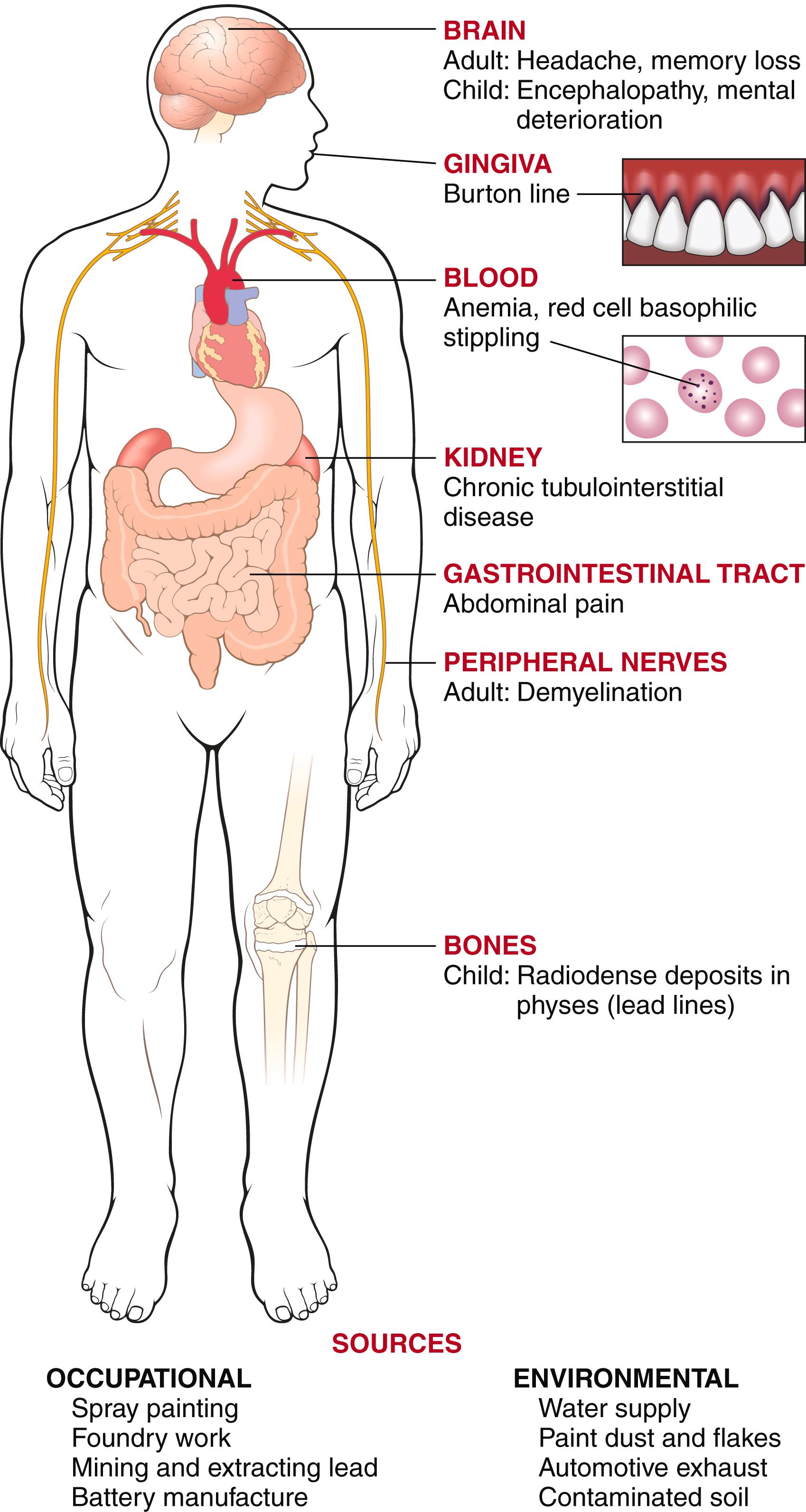
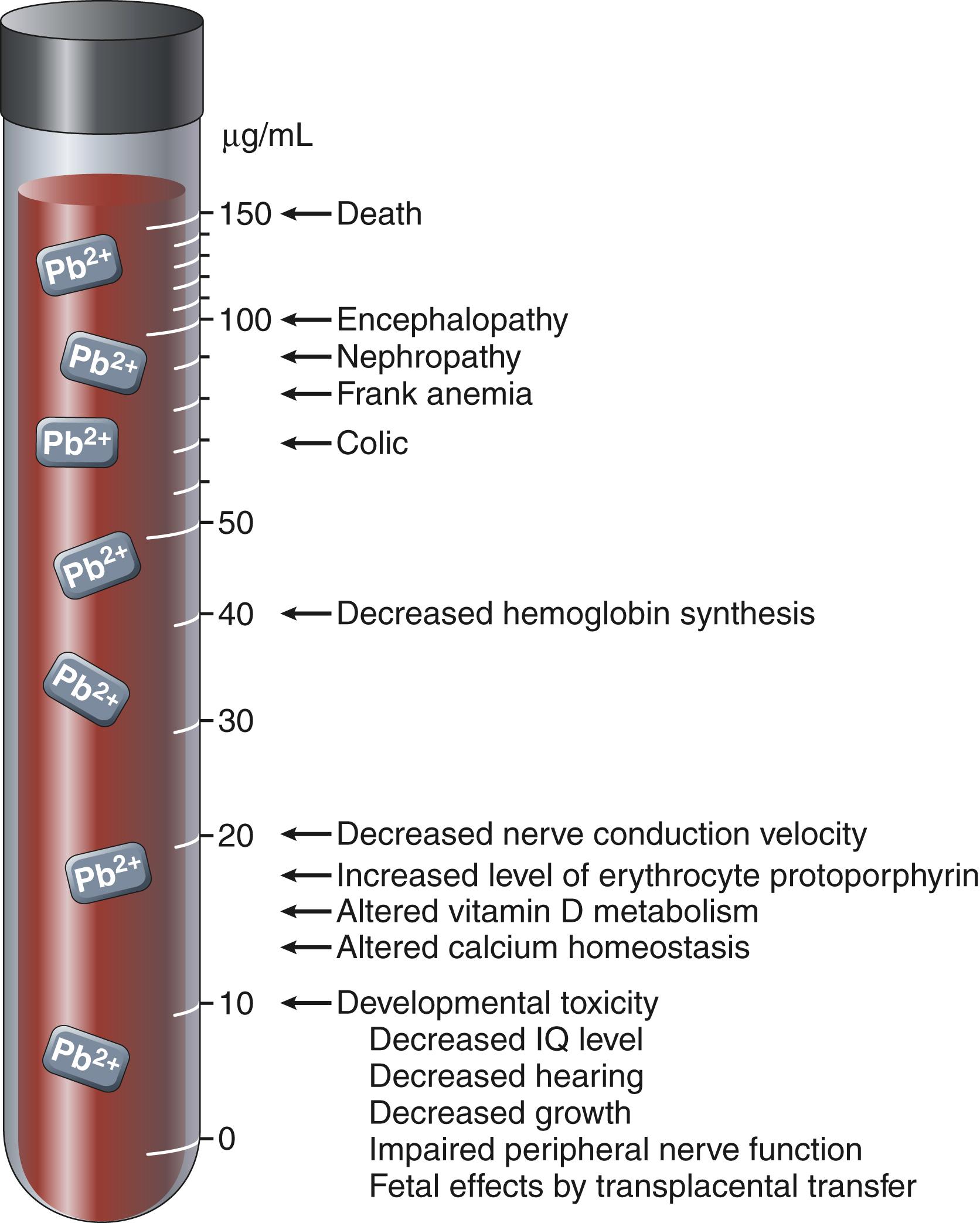
Excess lead interferes with the normal remodeling of the growth plate (physis) in children, causing increased bone density detected as radiodense “lead lines” ( Fig. 7.6 ). Lead inhibits the healing of fractures by increasing chondrogenesis and delaying cartilage mineralization. Linear hyperpigmentation in the gums can also be seen (Burton line). Acute exposures and renal excretion of lead may cause damage to proximal tubules.
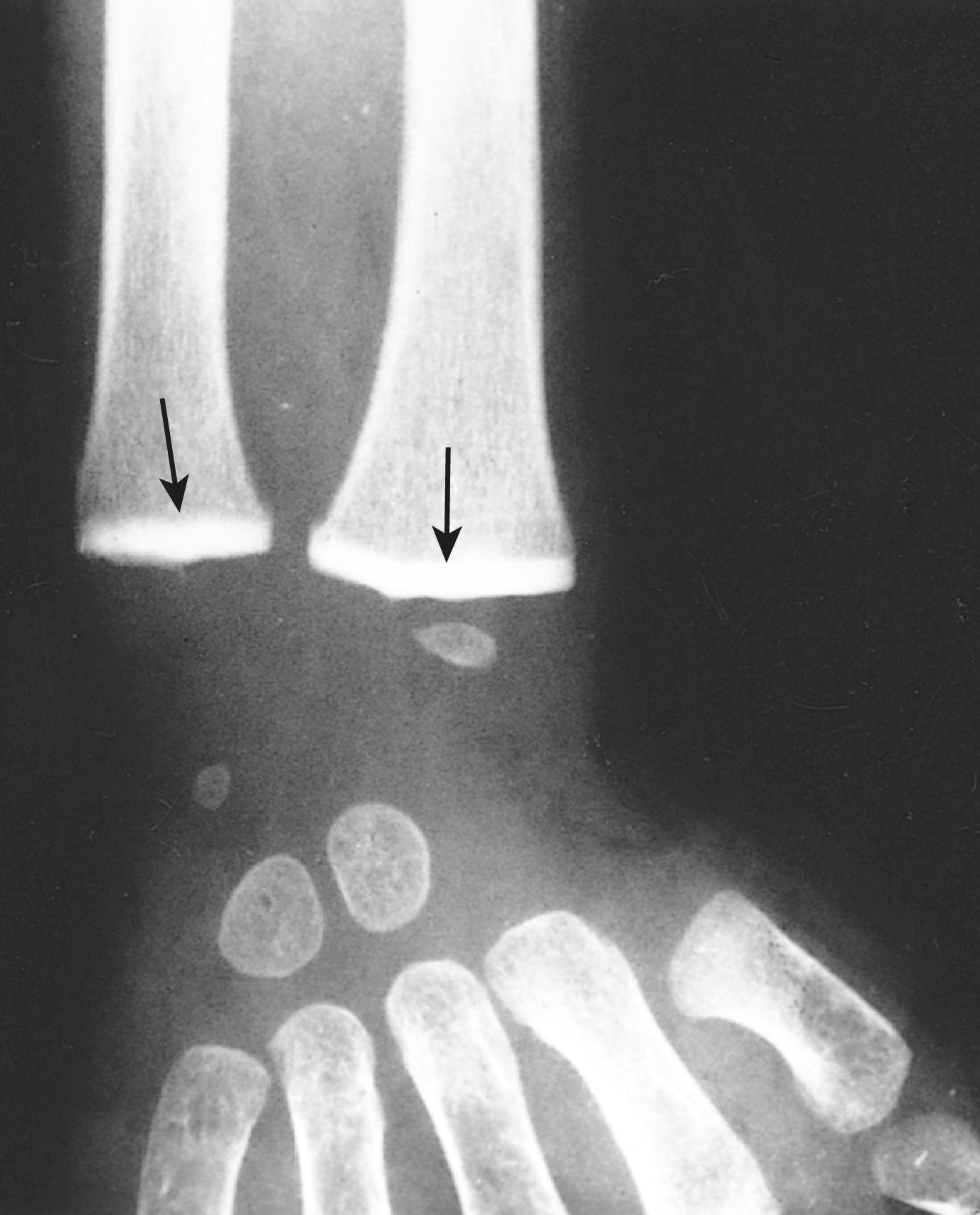
Lead has a high affinity for sulfhydryl groups and interferes with two enzymes involved in heme synthesis: delta-aminolevulinic acid dehydratase and ferrochelatase. Zinc-protoporphyrin (ZPP) is formed instead of heme, leading to decreased iron incorporation into heme and subsequent anemia. Lead also inhibits sodium- and potassium-dependent ATPases in cell membranes, an effect that may increase the fragility of red cells, causing hemolysis.
Lead poisoning may be suspected based on neurologic changes in children or unexplained anemia with basophilic stippling in red cells in adults and children. Elevated blood lead, red cell free protoporphyrin, or zinc-protoporphyrin levels are required for definitive diagnosis. In milder cases of lead exposure, anemia may be the only obvious finding.
The GI tract is also a site of major clinical manifestations: lead “colic” is characterized by severe, poorly localized abdominal pain that may mimic an acute abdomen. The mechanism is unclear.
The major anatomic targets of lead toxicity are the blood, bone marrow, nervous system, GI tract, and kidneys (see Fig. 7.5 ).
Blood changes are one of the earliest signs of lead accumulation and are characteristic, consisting of a microcytic, hypochromic anemia associated with a distinctive punctate basophilic stippling of red cells ( Fig. 7.7 ). These changes in the blood are due to reduced heme synthesis in marrow erythroid progenitors.
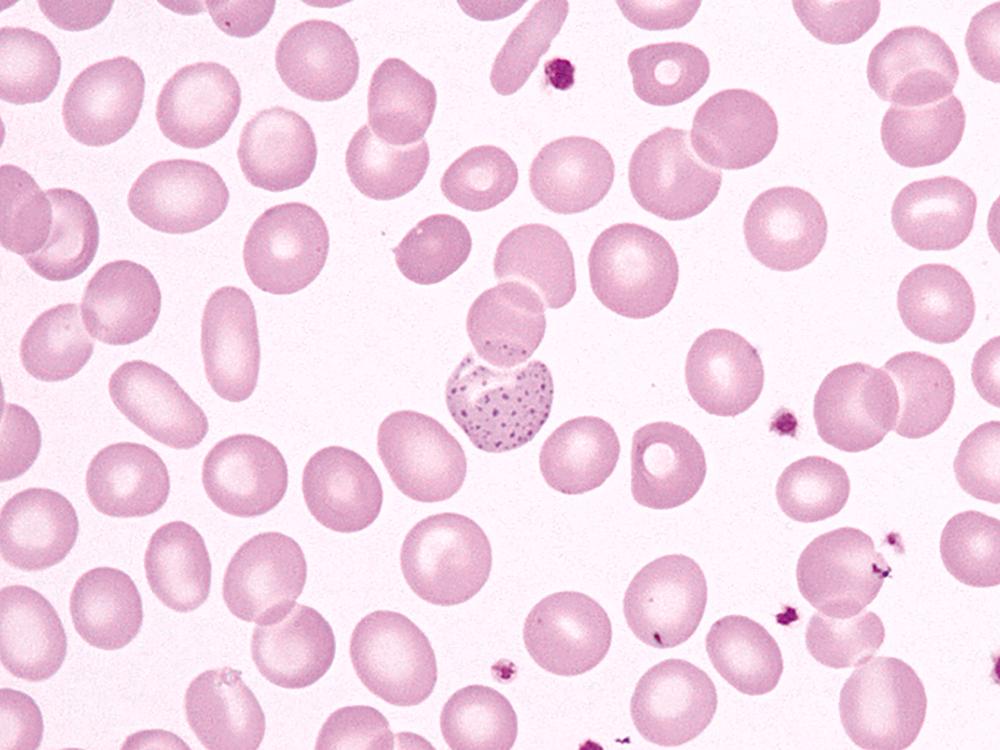
Brain damage is prone to occur in children. The anatomic changes underlying the more subtle functional deficits are ill defined; at the more severe end of the spectrum, changes include brain edema, demyelination of the cerebral and cerebellar white matter, and necrosis of cortical neurons accompanied by diffuse astrocytic proliferation. In adults, the CNS is less often affected, but peripheral demyelinating neuropathy can occur, typically involving motor neurons innervating the muscles that are most used. Thus, the extensor muscles of the wrist and fingers are often the first to be affected, followed by paralysis of the peroneal muscles ( wristdrop and footdrop ).
The kidneys may develop proximal tubular damage with intranuclear lead inclusions. Chronic renal damage leads eventually to interstitial fibrosis and sometimes renal failure and findings suggestive of gout. Other features of lead poisoning are shown in Fig. 7.5 .
Mercury, like lead, binds with high affinity to sulfhydryl groups, thereby inhibiting enzymes such as choline acetyl transferase, which is involved in the production of acetylcholine, and inactivating other proteins, leading to damage in the CNS and several other organs, such as the GI tract and the kidneys. Humans have used mercury in many ways throughout history, including as a pigment in cave paintings, a cosmetic, a remedy for syphilis, and a component of diuretics. Poisoning from inhalation of mercury vapors has long been recognized and is associated with tremor, gingivitis, and bizarre behavior, such as that of the “Mad Hatter” in Lewis Carroll’s Alice in Wonderland (mercury was formerly used in hat making).
Though no longer used in large-scale gold mining, mercury waste from that process as well as inorganic mercury from the Earth’s crust are converted to organic compounds such as methyl mercury by bacteria. Methyl mercury enters the food chain and concentrates in carnivorous fish (e.g., swordfish, shark, tuna), in which mercury levels may be 1 million times higher than in the surrounding water. Today the main sources of mercury exposure are contaminated fish. Almost 90% of ingested mercury is absorbed in the GI tract where it can cause precipitation of proteins in intestinal epithelial cells, leading to vomiting, abdominal pain, and bloody diarrhea. Mercury is cleared by the kidney which can cause renal damage. Acute toxicity is associated with renal tubular injury and oliguria or anuria. Because mercury is lipophilic, it concentrates in the CNS and can cross the placenta.
The developing brain is extremely sensitive to methyl mercury which can affect the motor, sensory, cognitive, and behavioral functions of the brain; for this reason, the CDC in the United States has recommended that individuals who are pregnant avoid consuming fish known to contain mercury and that reproductive age women limit their intake. Mercury exposure in utero can lead to cerebral palsy, deafness, blindness, and major CNS defects.
Arsenic binds to sulfhydryl groups on proteins and glutathione, thereby interfering with numerous enzymes (e.g., glutathione reductase, DNA ligases) and leading to toxicities that are most prominent in the GI tract, nervous system, skin, and heart. Arsenic was the poison of choice of skilled practitioners in the Borgia and Medici families in Renaissance Italy. Today, arsenic exposure is an important health problem in many areas of the world. Arsenic is found in soil and water and is used in wood preservatives, pesticides, and other agricultural products. It may be released into the environment by the mining and smelting industries. Arsenic is present in some traditional herbal medicines, and arsenic trioxide is a component of the treatment for acute promyelocytic leukemia ( Chapter 10 ). High concentrations of inorganic arsenic are present in ground water in several countries, particularly Bangladesh, where arsenic poisoning is a continuing health crisis. In the United States, arsenic contamination of rice has received attention since rice is a component of infant formula and cereals.
When ingested in large quantities, arsenic causes acute toxicity manifesting as severe abdominal pain, diarrhea, cardiac arrhythmias, shock, respiratory distress syndrome, and acute encephalopathy. GI, cardiovascular, and CNS toxicity may be sufficiently severe to cause death. These effects have been attributed to arsenic’s ability to interfere with mitochondrial oxidative phosphorylation. Chronic exposure to arsenic may lead to the development of a symmetric sensorimotor polyneuropathy and characteristically causes hyper- and/or hypopigmentation and hyperkeratosis of the skin ( eFig. 7.2 ), which may be followed by the development of basal cell and squamous cell carcinomas. In contrast to skin tumors induced by sunlight, arsenic-induced tumors frequently arise on the palms and soles. Arsenic exposure is also associated with an increased risk of lung carcinoma. The mechanisms of arsenic-induced carcinogenesis are uncertain.

Chronic cadmium exposure is toxic to the kidneys, lungs, and bones through uncertain mechanisms that may involve increased production of reactive oxygen species. Cadmium (Cd) principally enters the environment through industrial waste, in particular the production of nickel-cadmium batteries that can contaminate ground water and soil when disposed of in household waste. Agricultural crops may concentrate cadmium derived from the soil or from fertilizers and irrigation water. In the 1960s cadmium-contaminated water used to irrigate rice fields in Japan caused a disease known as “itai-itai” (“ouch-ouch”), a combination of osteoporosis and osteomalacia associated with multiple fractures and renal disease.
Cadmium is present in some foods (e.g., cereals, leafy vegetables) and in cigarette smoke, and these are the most important sources of exposure for the general population. Due to its long biologic half-life, cadmium continues to accumulate throughout an individual’s lifetime. Chronic cadmium excess can lead to emphysema and renal toxicity through unknown mechanisms, particularly in the setting of occupational exposure (e.g., smelting and refining of metals, recycling of nickel-cadmium batteries). Skeletal abnormalities are associated with increased urinary excretion of calcium and phosphorus, which can also lead to kidney stones.
More than 10 million occupational injuries occur annually in the United States, and approximately 65,000 people die each year as a consequence of occupational injuries and illnesses. Industrial exposures to toxic agents are as varied as the industries themselves, ranging from simple irritation of respiratory airways by formaldehyde or ammonia fumes, to lung cancers arising from exposure to asbestos, arsenic, or uranium. Human diseases associated with occupational exposures are listed in Table 7.2 . In addition to toxic metals (already discussed), other important agents that contribute to environmental diseases include the following:
Organic solvents , such as chloroform and toluene, are widely used in vast quantities worldwide, primarily in industry. Acute exposure to high levels of vapors from these agents can cause dizziness, confusion, CNS depression, and even coma. Lower levels may cause liver and kidney toxicity. Occupational exposure and residential proximity to hazardous waste sites containing organic solvents, particularly benzene, are associated with an increased risk of leukemia. Benzene is oxidized to an epoxide through hepatic CYP2E1, a component of the P-450 enzyme system. This and other metabolites disrupt progenitor cell differentiation in the bone marrow and may lead to marrow aplasia and acute myeloid leukemia.
Polycyclic hydrocarbons are released during the combustion of coal and gas, particularly at the high temperatures used in steel foundries, and are also present in tar and soot. When metabolized, polycyclic hydrocarbons form potent carcinogens that can covalently attach to DNA, leading to mutations and changes in gene expression that can cause neoplasia.
Organochlorines (and halogenated organic compounds in general) are synthetic products that resist degradation and are lipophilic. Important organochlorines used as pesticides are DDT (dichlorodiphenyltrichloroethane) and its metabolites, and agents such as lindane, aldrin, and dieldrin, all of which have been banned in the United States due to concerns about toxicity. Although DDT was banned in 1973, its long-lasting metabolite p,p′-DDE is detectable in the serum of much of the American population, including individuals born after the ban went into effect. Acute organochlorine toxicity primarily affects the body through stimulating the central nervous system by interfering with sodium channel activity (DDT) or by inhibiting GABA receptors (lindane, aldrin).
Nonpesticide organochlorines include polychlorinated biphenyls (PCBs) and dioxin (TCDD [2,3,7,8-tetrachlorodibenzo-p-dioxin]). High doses of dioxins and PCBs can cause skin disorders such as chloracne, which is characterized by acne, cyst formation, hyperpigmentation, and hyperkeratosis, generally around the face and behind the ears. The mechanism is thought to be related to activation of a signaling pathway mediated by an aryl hydrocarbon receptor in skin stem cell progenitors. Other findings include liver dysfunction, encephalopathy, and transient peripheral neuropathy. Because PCBs induce the P-450 enzyme system, workers exposed to these substances may show altered drug metabolism. Low levels of PCB and TCDD are present in the blood of most of the US population. Most organochlorines are endocrine disruptors (i.e., they may mimic hormones or affect hormone levels) with antiestrogenic or antiandrogenic activity in laboratory animals, but long-term health effects in humans have not been firmly established.
Bisphenol A (BPA) is used in the synthesis of polycarbonate food and water containers and of epoxy resins that line almost all food bottles and cans; as a result, exposure to BPA is virtually ubiquitous in humans. BPA is a proven endocrine disruptor; though its effect is weak, its omnipresence is cause for concern. There is some evidence that early exposure to BPA may increase the risk of chronic diseases such as diabetes, cancer, and hypertension in adulthood due to its hormone-like properties. In 2010 Canada was the first country to list BPA as a toxic substance; in 2012 its use was banned in baby bottles and “sippy” cups in the United States. However, potential replacements for BPA, such as bisphenol S and bisphenol F, have similar structures and research has questioned their safety.
Vinyl chloride, used in the synthesis of polyvinyl resins, can cause angiosarcoma of the liver, a rare type of liver tumor.
Inhalation of certain mineral dusts, inorganic particulates, and fumes and vapors may cause chronic, nonneoplastic lung diseases called pneumoconioses. This group of disorders includes diseases induced by organic and inorganic particulates as well as chemical fume- and vapor-induced nonneoplastic lung diseases. The most common pneumoconioses are caused by exposures to coal dust (in mining of hard coal), silica (in sandblasting and stone cutting), asbestos (in mining, fabrication, and insulation work), and beryllium (in mining and fabrication). Exposure to these agents nearly always occurs in the workplace. Notably, the increased risk of cancer because of asbestos exposure extends to family members of asbestos workers due to residua carried on the workers’ clothing. Pneumoconioses and their pathogenesis are discussed in Chapter 11 .
| Organ/System | Effect(s) | Environmental Toxins |
|---|---|---|
| Cardiovascular system | Heart disease | CO, lead, solvents, cobalt, cadmium |
| Respiratory system | Nasal cancer | Wood dust, leather dust |
| Lung cancer | Radon, asbestos, silica, bis(chloromethyl) ether, nickel, arsenic, chromium, mustard gas | |
| Chronic obstructive pulmonary disease | Grain dust, coal dust, cadmium | |
| Hypersensitivity | Beryllium, isocyanates | |
| Irritation | Ammonia, sulfur oxides, formaldehyde | |
| Fibrosis | Silica, asbestos, cobalt | |
| Nervous system | Peripheral neuropathies | Solvents, acrylamide, methyl chloride, mercury, lead, arsenic, DDT |
| Ataxic gait | Chlordane, toluene, acrylamide, mercury | |
| CNS depression | Alcohols, ketones, aldehydes, solvents | |
| Cataracts | Ultraviolet radiation | |
| Urinary system | Renal toxicity | Mercury, lead, glycol ethers, solvents |
| Bladder cancer | Naphthylamines, 4-aminobiphenyl, benzidine, rubber products | |
| Reproductive system | Male infertility | Lead, dibromochloropropane, cadmium, mercury |
| Female infertility | Cadmium, lead, phthalates | |
| Teratogenesis | Mercury, polychlorinated biphenyls | |
| Hematopoietic system | Leukemia | Benzene, radon, uranium |
| Skin | Folliculitis and chloracne | Polychlorinated biphenyls, dioxins, herbicides |
| Cancer | Ultraviolet radiation | |
| GI tract | Liver angiosarcoma | Vinyl chloride |
Tobacco is the most common exogenous cause of human cancers, being responsible for 80% to 90% of lung cancers. The primary contributor is cigarette smoking, which is causal in cardiovascular disease, various types of cancer, and chronic respiratory diseases. Smokeless tobacco in its various forms (e.g., chewing tobacco) is also harmful to health and is an important cause of oral cancer. Not only does the use of tobacco products create personal risk, but also passive tobacco inhalation from the environment (“second-hand smoke”) can cause lung cancer in nonsmokers. The percentage of Americans who smoke cigarettes has decreased from 20.9% in 2005 to 14% in 2019, and about 34 million Americans are current smokers. In the United States, tobacco is responsible for about 480,000 deaths per year. Worldwide, there are 1.3 billion tobacco users, with more than 80% living in low- and middle-income countries. More than 8 million deaths per year are attributed to tobacco use.
Smoking is the most important cause of preventable human death. It reduces overall survival in a dose-dependent fashion. Whereas 80% of nonsmokers are alive at age 70, only about 50% of smokers survive to this age ( Fig. 7.8 ). Within 5 years, cessation of smoking greatly reduces overall mortality and the risk of death from cardiovascular diseases. Lung cancer mortality decreases by 21% within 5 years, but the excess risk persists for 30 years. Adverse effects of smoking in various organ systems are shown in Fig. 7.9 .
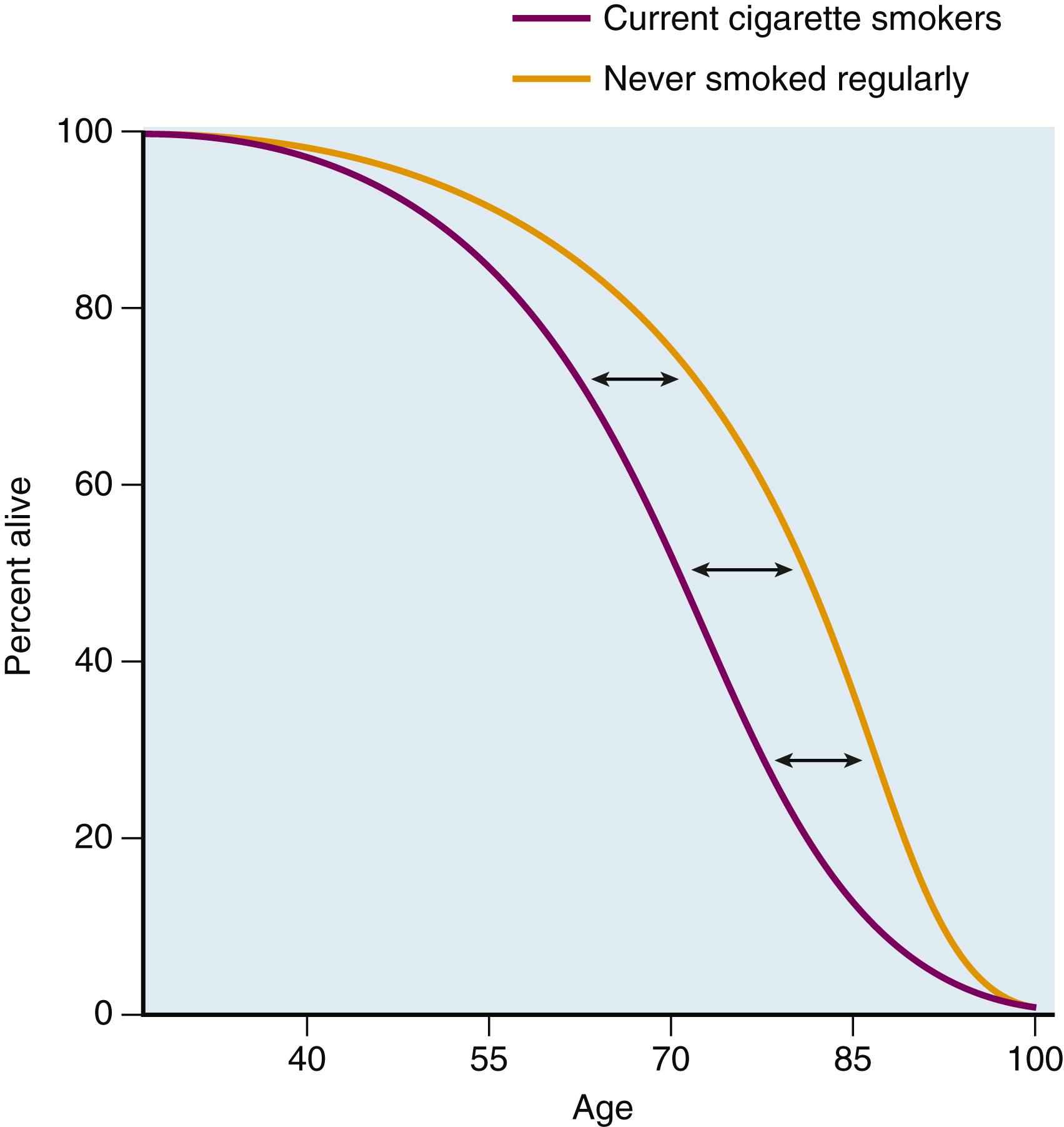
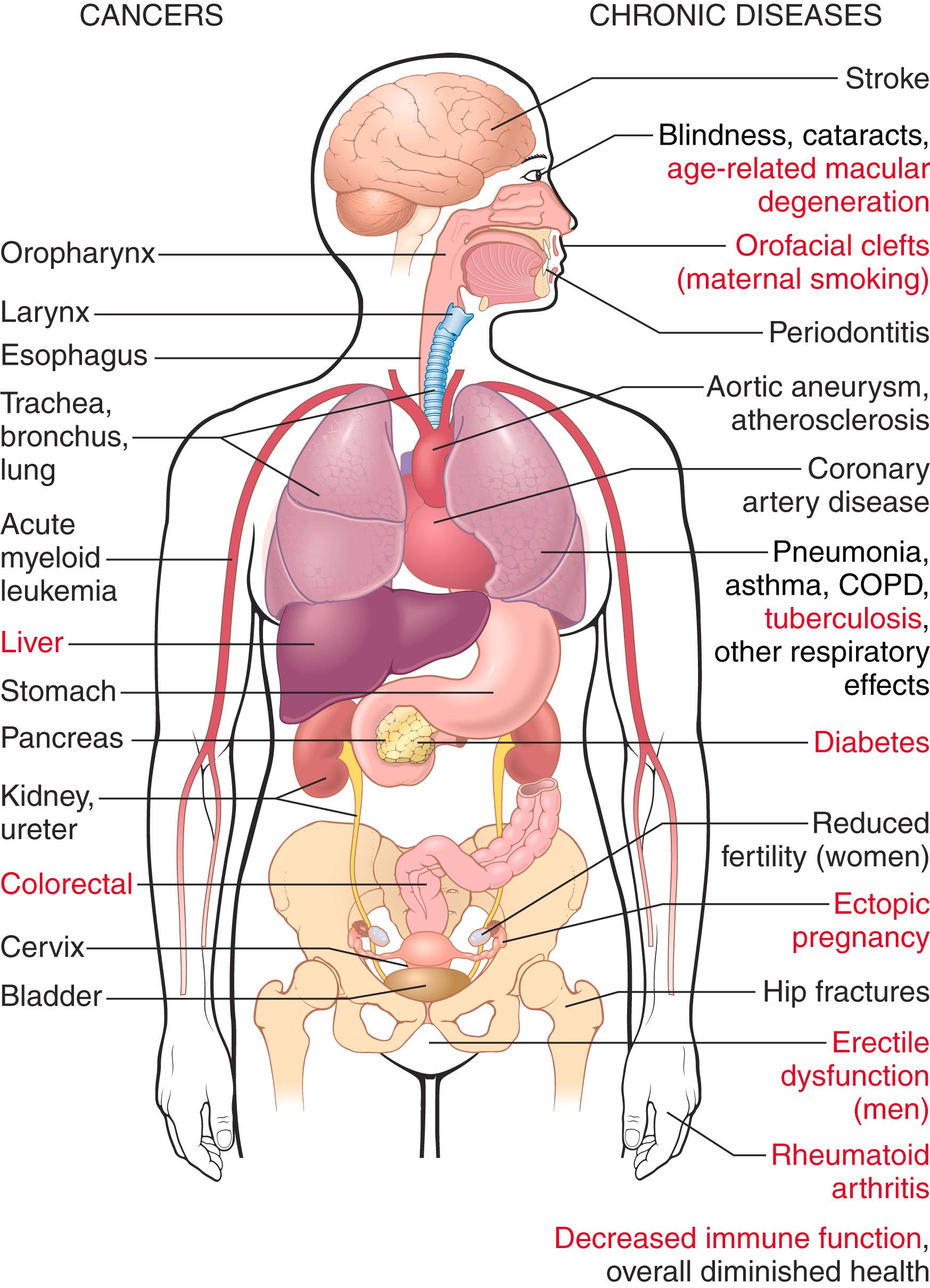
The number of potentially harmful chemicals in tobacco smoke is vast; Table 7.3 presents a partial list and includes the type of injury produced by these agents. Nicotine, an alkaloid present in tobacco leaves, is not a direct cause of tobacco-related diseases but is highly addictive. Nicotine binds to receptors in the brain and, through the release of catecholamines, is responsible for the acute effects of smoking, such as increased heart rate and blood pressure and increased cardiac contractility and output.
| Substance | Effect(s) |
|---|---|
| Tar | Carcinogenesis |
| Polycyclic aromatic hydrocarbons | Carcinogenesis |
| Nicotine | Ganglionic stimulation and depression, tumor promotion |
| Phenol | Tumor promotion; mucosal irritation |
| Benzopyrene | Carcinogenesis |
| Carbon monoxide | Impaired oxygen transport and use |
| Formaldehyde | Toxic to cilia; mucosal irritation |
| Oxides of nitrogen | Toxic to cilia; mucosal irritation |
| Nitrosamine | Carcinogenesis |
The most common diseases caused by cigarette smoking involve the lung and include emphysema, chronic bronchitis, and lung cancer, all discussed in Chapter 11 . The mechanisms responsible for some tobacco-induced diseases include the following:
Direct irritant effect on the tracheobronchial mucosa, producing inflammation and increased mucus production (bronchitis). Cigarette smoke also causes the recruitment of leukocytes to the lung, increasing local elastase production and subsequent injury to lung tissue that leads to emphysema.
Carcinogenesis. Components of cigarette smoke, particularly polycyclic hydrocarbons and nitrosamines ( Table 7.4 ), are potent carcinogens in animals and are involved in the pathogenesis of lung carcinomas in humans (see Chapter 11 ). The risk of developing lung cancer is related to the intensity of exposure, frequently expressed in terms of “pack years” (e.g., one pack daily for 20 years equals 20 pack years) or in cigarettes smoked per day ( Fig. 7.10 ). In addition to lung cancers, tobacco smoke contributes to the development of cancers of the oral cavity, esophagus, pancreas, and bladder (see Table 7.4 ). Moreover, smoking multiplies the risk associated with other carcinogens; well-recognized examples are the 10-fold increased incidence of lung carcinomas in asbestos workers and uranium miners who smoke compared to those who do not. The combination of tobacco (chewed or smoked) and alcohol consumption has multiplicative effects on the risks of oral, laryngeal, and esophageal cancers. An example of the carcinogenic interaction of these two factors is shown for laryngeal cancer ( Fig. 7.11 ).
| Organ | Carcinogen(s) |
|---|---|
| Lung, larynx | Polycyclic aromatic hydrocarbons |
| 4-(Methylnitrosoamino)-1-(3-pyridyl)-1-butanone Nicotine-derived nitrosamine ketone (NNK) |
|
| 210 Polonium | |
| Esophagus | N′-Nitrosonornicotine (NNN) |
| Pancreas | NNK (?) |
| Bladder | 4-Aminobiphenyl, 2-naphthylamine |
| Oral cavity: smoking | Polycyclic aromatic hydrocarbons, NNK, NNN |
| Oral cavity: chewing tobacco | NNK, NNN, 210 polonium |
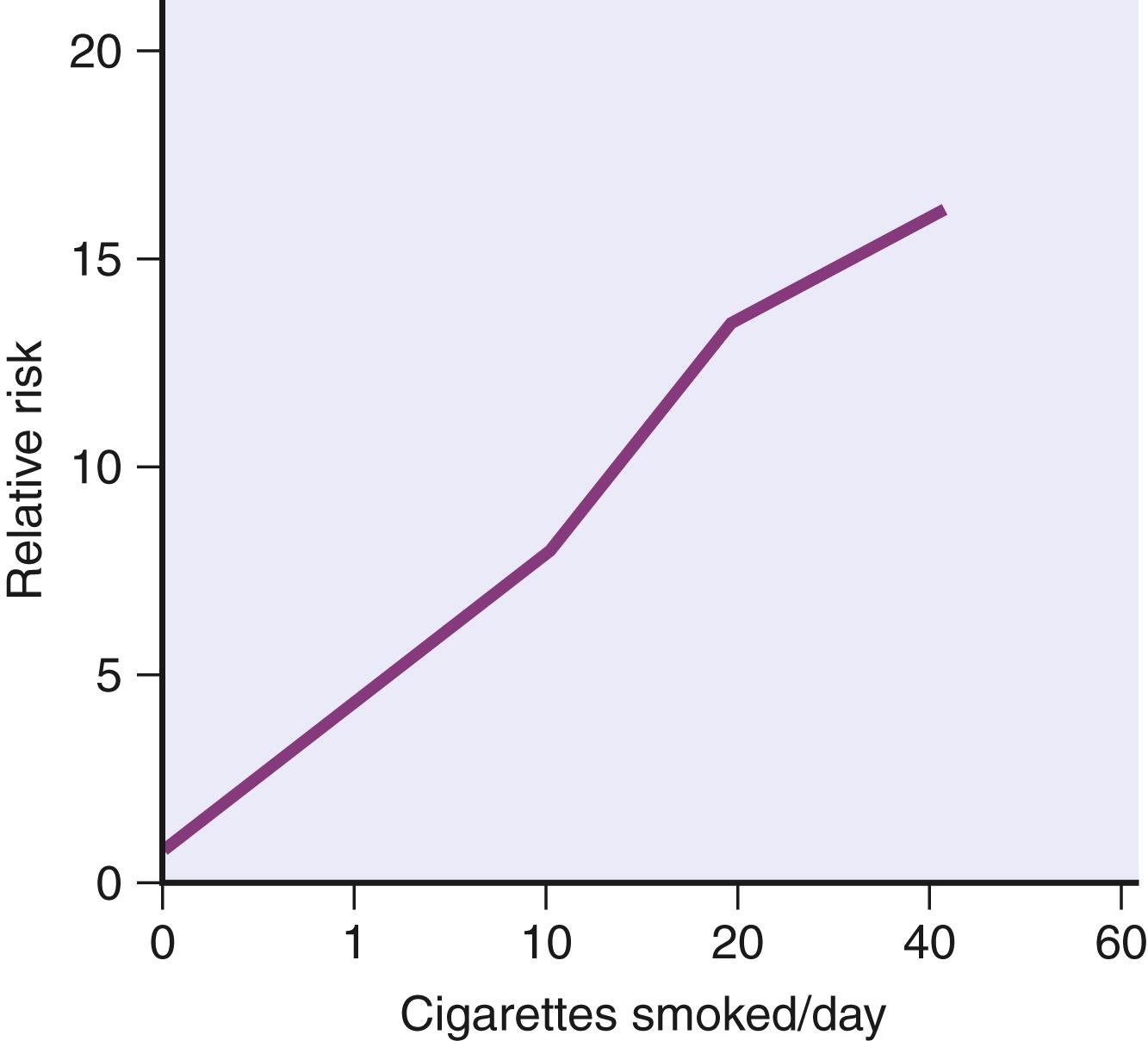
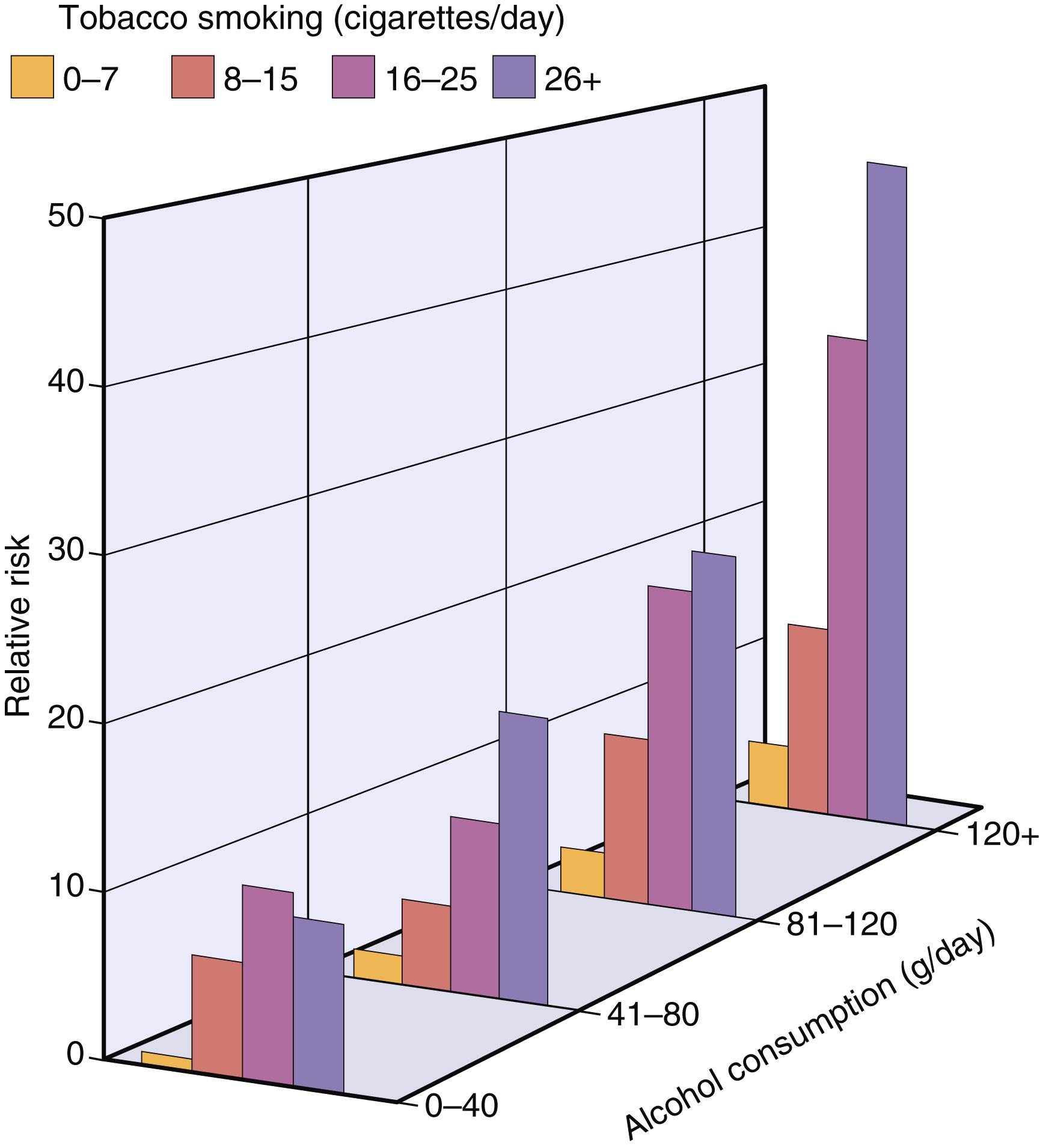
Atherosclerosis and its major complication, myocardial infarction, are strongly linked to cigarette smoking. The causal mechanisms probably relate to several factors, including increased platelet aggregation, decreased myocardial oxygen supply (due to lung disease coupled with hypoxia related to CO in cigarette smoke) accompanied by increased oxygen demand, and a decreased threshold for ventricular fibrillation. According to the CDC, about 20% of all cardiovascular deaths are caused by cigarette smoking. Smoking has a multiplicative effect on risk when combined with hypertension and hypercholesterolemia.
The 2016 US Surgeon General’s report added several additional diseases to the previously known list of smoking-associated diseases (see Fig. 7.9 ), including type 2 diabetes, rheumatoid arthritis, age-related macular degeneration, ectopic pregnancy, and erectile dysfunction.
Maternal smoking increases the risk of spontaneous abortions and preterm births and results in intrauterine growth retardation ( Chapter 4 ); however, birth weights of infants born to mothers who stopped smoking before pregnancy are within the normal range.
Passive smoke inhalation is also associated with detrimental effects. It is estimated that the relative risk of lung cancer in nonsmokers exposed to environmental smoke is about 1.3 times that in nonsmokers who are not exposed to smoke. In the United States, more than 7000 adult lung cancer deaths and more than 30,000 cardiac deaths are attributed annually to environmental tobacco smoke. Children living in a household with an adult who smokes have an increased frequency of respiratory illnesses and asthma.
E-cigarettes deliver an aerosol of nicotine and other components that is inhaled. Although there are few long-term data, it is thought that risk of cardiopulmonary disease and cancer is lower than with conventional tobacco cigarettes. However, e-cigarette use (vaping) may be associated with a form of acute lung injury related to compounds in the vaping fluid and typically presents with dyspnea, cough, and GI symptoms. Pathologic changes in the lung vary from organizing pneumonia to diffuse alveolar damage (discussed in Chapter 11 ).
Despite the attention focused on use of illicit substance use, excessive alcohol use is a more widespread hazard and claims many more lives. A person who drinks excessively does not necessarily meet the Diagnostic and Statistical Manual of Mental Disorders (DSM-V) criteria for an alcohol use disorder (AUD). Similarly, individuals who drink what most people would consider a moderate amount may still meet criteria for an AUD, depending on their life situation and consequences of their alcohol consumption.
It is estimated that 1 in 8 Americans meets the criteria for AUD and that excess alcohol consumption is directly responsible for approximately 95,000 deaths annually, about 10,000 of which are due to alcohol-related motor vehicle accidents. The remaining deaths are secondary to alcohol-related homicides and suicides, cirrhosis of the liver, cardiac disease, and cancer. In the United States, approximately 75,000 cancer cases and 19,000 cancer deaths are attributable to alcohol each year.
After consumption, ethanol is absorbed unaltered in the stomach and small intestine and then distributes to the tissues and fluids of the body in direct proportion to the blood level. Less than 10% is excreted unchanged in the urine, sweat, and breath. The amount exhaled is proportional to the blood level and forms the basis for the breath alcohol test. The federal legal driving limit for blood alcohol content is 0.08%, though states may set a lower limit, and lower limits may apply for drivers under the age of 21 years. Many factors determine blood alcohol concentration including sex, age, medications, and rate of consumption. Drowsiness occurs at 200 mg/dL, stupor at 300 mg/dL, and coma, with possible respiratory arrest, at higher levels. Over time, sustained heavy alcohol use increases its rate of metabolism and can lead to the development of tolerance; as a result, when the same amount of alcohol is consumed, lower peak alcohol levels are seen in heavy alcohol drinkers than in seldom drinkers.
Blood alcohol is metabolized to acetaldehyde in the liver by one of three enzyme systems: alcohol dehydrogenase (in the cytosol of hepatocytes), cytochrome P-450 isoenzymes (in the microsomes), and catalase (in the peroxisomes) ( Fig. 7.12 ). Of these, the main enzyme involved in alcohol metabolism is alcohol dehydrogenase. At high blood alcohol levels, the microsomal ethanol-oxidizing system also plays an important role. This system involves cytochrome P-450 enzymes, particularly the CYP2E1 isoform. As alcohol is an inducer of P-450 enzymes, heavy alcohol use can increase an individual’s susceptibility to other compounds metabolized by the same enzyme system, which include drugs (e.g., acetaminophen, cocaine), anesthetics, carcinogens, and industrial solvents. When alcohol is present in the blood at high concentrations, it competes with other CYP2E1 substrates such as medications and may delay their catabolism, thereby potentiating their effects. Catalase is of minor importance, being responsible for about 5% of alcohol metabolism. Acetaldehyde produced by these systems is in turn converted by acetaldehyde dehydrogenase to acetate, which is used in the mitochondrial respiratory chain.
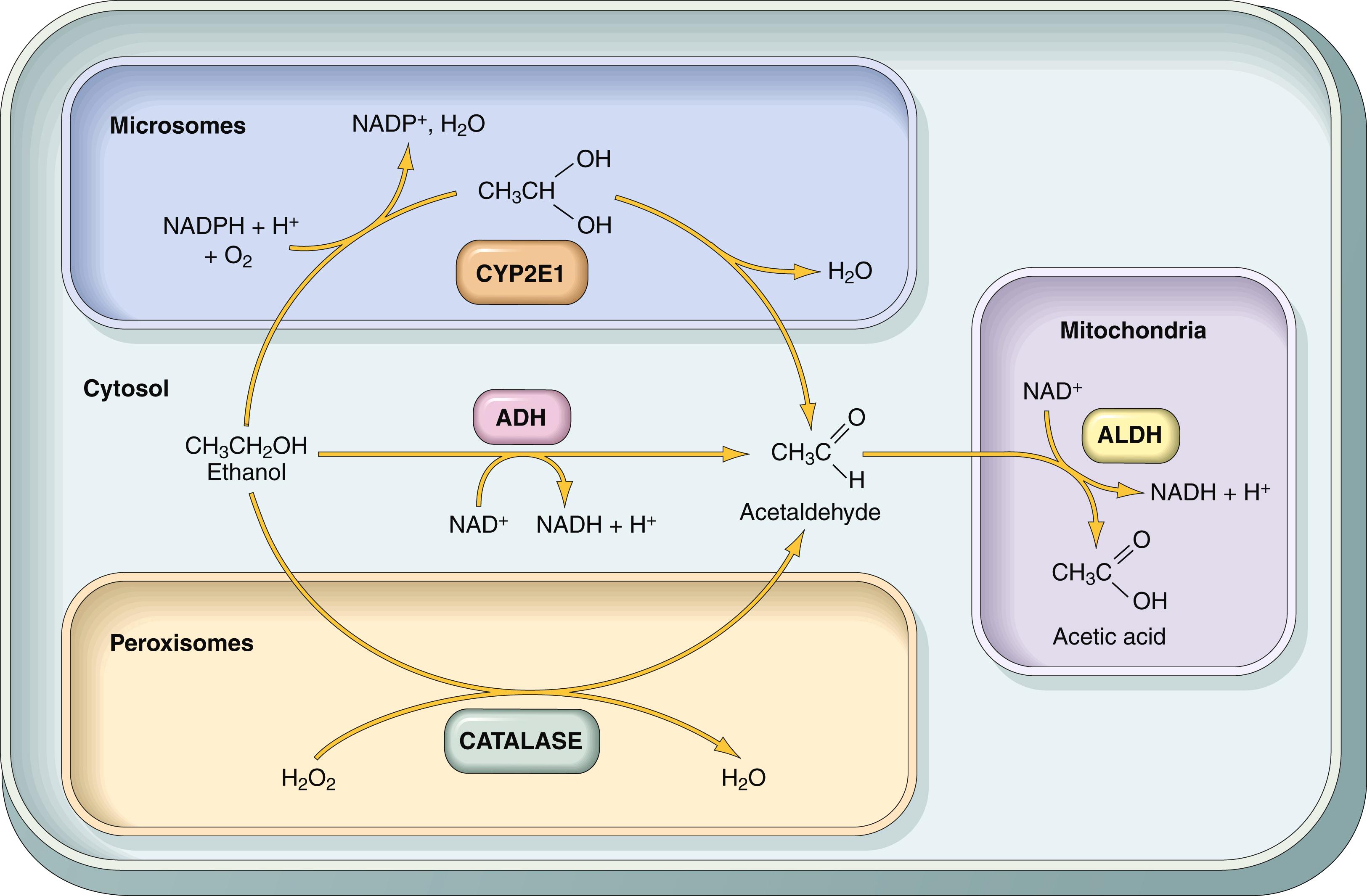
Several toxic effects result from ethanol metabolism. Listed here are the most important of these:
Alcohol oxidation by alcohol dehydrogenase causes a decrease in nicotinamide adenine dinucleotide (NAD + ) and an increase in NADH (the reduced form of NAD + ). Since NAD + is required for hepatic fatty acid oxidation, excess alcohol intake can lead to fat accumulation in the liver over time. In addition, the increase in the NADH/NAD + ratio can result in lactic acidosis.
Acetaldehyde toxicity may be responsible for some of the acute effects of alcohol. Acetaldehyde metabolism differs between populations due to genetic variation. One polymorphism that originated in China causes acetaldehyde accumulation in individuals of East Asian descent (e.g., China, Korea, Japan). After ingesting alcohol, individuals with this allele experience flushing, tachycardia, and hyperventilation.
ROS generation. Metabolism of ethanol in the liver by CYP2E1 produces ROS and causes lipid peroxidation of cell membranes. However, the precise mechanisms that account for alcohol-induced cellular injury have not been well defined.
Endotoxin release. Alcohol may cause the release of endotoxin (lipopolysaccharide), a product of gram-negative bacteria, from the intestinal flora. Endotoxin stimulates the release of tumor necrosis factor (TNF) and other cytokines from macrophages and from Kupffer cells in the liver, causing cell injury.
Acutely, excess alcohol exerts its effects mainly on the CNS but may also induce reversible hepatic and gastric injuries. Even with moderate alcohol intake, multiple fat droplets accumulate in hepatocytes ( fatty change or hepatic steatosis ). Gastric damage occurs in the form of acute gastritis and ulceration . In the CNS, alcohol is a depressant, first affecting subcortical structures that modulate cerebral cortical activity followed by stimulation and disordered cortical, motor, and intellectual behavior. At progressively higher blood levels, cortical neurons and then lower medullary centers are depressed, including those that regulate respiration. Respiratory arrest may follow.
Sustained excessive alcohol intake has been associated with increased morbidity and shortened life span, related principally to damage to the liver, GI tract, CNS, cardiovascular system, and pancreas.
The liver is the main site of chronic injury. In addition to fatty change, mentioned earlier, chronic excess alcohol intake can lead to steatohepatitis and cirrhosis ( Chapter 14 ). Cirrhosis is associated with portal hypertension and an increased risk of hepatocellular carcinoma.
In the GI tract, chronic excess alcohol intake can cause massive bleeding from gastritis, gastric ulcer, or esophageal varices (associated with cirrhosis), which may prove fatal.
Neurologic effects. Thiamine deficiency is common in the setting of sustained heavy alcohol intake; the principal lesions resulting from this deficiency are peripheral neuropathies and the Wernicke-Korsakoff syndrome ( Chapter 21 ). Cerebral atrophy, cerebellar degeneration, and optic neuropathy may also occur.
Cardiovascular effects. Alcohol has diverse effects on the cardiovascular system. Injury to the myocardium may produce dilated congestive cardiomyopathy (alcohol-related cardiomyopathy) ( Chapter 9 ). Chronic heavy alcohol consumption increases risk for coronary heart disease and hypertension.
Pancreatitis. Excess alcohol intake increases the risk of acute and chronic pancreatitis ( Chapter 15 ).
Effects on the fetus. No safe level for alcohol use during pregnancy has been established; consequently, abstinence is recommended, particularly during the first trimester. The use of alcohol during pregnancy can cause fetal alcohol syndrome, which is marked by microcephaly, growth retardation, and facial dysmorphism in the newborn ( Chapter 4 ). Brain dysfunction may not become apparent until children are older.
Carcinogenesis. Chronic alcohol consumption is associated with an increased incidence of cancer, particularly in heavy drinkers. Cancers of the upper airways and digestive tract (oral cavity, pharynx, esophagus, and larynx) and liver (secondary to cirrhosis) are most closely linked to heavy alcohol use. Low to moderate levels of alcohol use increase the risk of breast cancer. The mechanisms of the carcinogenic effect are uncertain; however, alcohol and cigarette smoke synergize in the causation of various cancers.
Malnutrition. Ethanol is a substantial source of calories but is often consumed at the expense of food. Chronic alcohol use is thus associated with malnutrition and deficiencies, particularly of B vitamins.
Adverse drug reactions (ADRs) are untoward effects of drugs that are administered in conventional therapeutic settings. ADRs are extremely common, affecting almost 7% of patients admitted to a hospital, and are often serious, accounting for over 100,000 deaths annually. Table 7.5 lists common pathologic findings in ADRs and the drugs most frequently involved. Many of the drugs causing ADRs, such as the antineoplastic agents, are toxic at doses that are predicted to achieve maximal therapeutic effects. Because they are widely used, estrogens and oral contraceptives (OCs) are discussed next in more detail. In addition, acetaminophen and aspirin, nonprescription drugs that are important causes of accidental or intentional overdose, merit consideration.
| Reaction | Major Offenders |
|---|---|
| Blood Dyscrasias a | |
| Granulocytopenia, aplastic anemia, pancytopenia | Antineoplastic agents, immunosuppressives, chloramphenicol |
| Hemolytic anemia, thrombocytopenia | Penicillin, methyldopa, quinidine |
| Cutaneous | |
| Urticaria, macules, papules, vesicles, petechiae, exfoliative dermatitis, fixed drug eruptions, abnormal pigmentation | Antineoplastic agents, sulfonamides, hydantoins, some antibiotics, and many other agents |
| Cardiac | |
| Arrhythmias | Theophylline, hydantoins |
| Cardiomyopathy | Doxorubicin, daunorubicin |
| Renal | |
| Glomerulonephritis | Penicillamine |
| Acute tubular injury | Aminoglycoside antibiotics, cyclosporine, amphotericin B |
| Tubulointerstitial disease with papillary necrosis | Phenacetin, salicylates |
| Pulmonary | |
| Asthma | Salicylates |
| Acute pneumonitis | Nitrofurantoin |
| Interstitial fibrosis | Busulfan, nitrofurantoin, bleomycin |
| Hepatic | |
| Fatty change | Tetracycline |
| Diffuse hepatocellular damage | Halothane, isoniazid, acetaminophen |
| Cholestasis | Chlorpromazine, estrogens, contraceptive agents |
| Systemic | |
| Anaphylaxis | Penicillin |
| Lupus erythematosus syndrome (drug-induced lupus) | Hydralazine, procainamide |
| Central Nervous System | |
| Tinnitus and dizziness | Salicylates |
| Acute dystonic reactions and parkinsonian syndrome | Phenothiazine antipsychotics |
| Respiratory depression | Sedatives |
The most common type of menopausal hormone therapy (MHT) consists of the administration of an estrogen together with a progestogen. In women who have had hysterectomies, the carcinogenic risk of progestogen on the uterus is eliminated and they may be treated solely with estrogen. Though MHT was initially used primarily to counteract hot flashes and other symptoms of menopause, early clinical studies suggested that MHT in postmenopausal women could prevent or slow the progression of osteoporosis ( Chapter 19 ) and reduce the likelihood of myocardial infarction. However, subsequent randomized clinical trials revealed several adverse cardiovascular effects of MHT, including increased risk of stroke, congestive heart failure, and venous thromboembolism. Several mechanisms have been proposed for the deleterious effects of MHT, including increased serum triglycerides, reduced levels of antithrombotic factors (e.g., fibrinogen, factor VII, antithrombin), increased production of proinflammatory markers and increased resistance to activated protein C, which results in a prothrombotic state due to dysregulation of factors V and VIII ( Chapter 3 ). An increased risk of breast cancer was also noted. As a result, use of MHT has declined significantly in the United States, despite recent studies that support a more individualized approach to MHT. These newer analyses showed that MHT effects depend on several factors:
Type of regimen. Combination estrogen-progesterone treatment increases the risk of breast cancer. By contrast, estrogen alone in women with hysterectomy is associated with a borderline reduction in risk of breast cancer. There is no increase in ovarian cancer risk.
Age. MHT may have a protective effect on the development of atherosclerosis and coronary disease in women younger than age 60 years, but there is no protection in women who start MHT at an older age.
Duration of treatment. When taken for less than 4 to 5 years, combined estrogen-progestin MHT does not appear to increase breast cancer risk; risk increases with longer durations.
Route of administration. Transdermal estrogen is associated with a lower risk of venous thromboembolism and stroke compared to oral estrogen preparations.
Baseline risk for cardiovascular disease, thromboembolism (e.g., factor V Leiden allele), and breast carcinoma. Depending on risk assessment, nonhormonal therapies may be indicated in individuals at increased risk for these conditions.
Assessment of risks and benefits when considering the use of MHT is complex. Current recommendations indicate that, while these agents have a role in managing the symptoms of early menopause in selected patients, they should not be used long term for disease prevention.
Combined hormonal (estrogen-progestin) contraception has evolved from high-dose estrogen formulations (100 μg) to much lower doses (less than 35 μg of ethinyl estradiol in monophasic oral preparations) and has expanded from oral contraceptive pills (OCs) to include transvaginal rings and dermal patches. Epidemiologic studies must be interpreted in the context of the changing dosage. Nevertheless, there is reasonable evidence to support the following conclusions:
Breast carcinoma: There is a small (∼1.2-fold) increased risk of breast cancer in women using OCs.
Endometrial cancer and ovarian cancers: OCs have a protective effect against these tumors.
Cervical cancer: OCs may increase the risk of cervical carcinomas in women infected with human papillomavirus.
Thromboembolism: Combined hormone therapy of all types is associated with an increased risk of thromboembolism due to increased hepatic synthesis of coagulation factors. It is therefore contraindicated in women with thrombophilia (e.g., factor V Leiden) who are not receiving anticoagulation therapy.
Cardiovascular disease: There is considerable uncertainty about the risk of atherosclerosis and myocardial infarction associated with OCs. It seems that OCs do not increase the risk of coronary artery disease in women younger than 30 years or in older women who are nonsmokers, but the risk is approximately double in women older than 35 years who smoke.
Hepatic adenoma: There is a well-defined association between the use of OCs and this rare benign hepatic tumor ( Chapter 14 ), especially in older women who have used OCs for prolonged periods.
These hazards must be viewed in the context of the wide availability and relative safety of combined hormone contraception. This is a changing field so therapy must be based on the latest available data.
At therapeutic doses, acetaminophen, a widely used nonprescription analgesic and antipyretic, is mostly conjugated in the liver with glucuronide or sulfate. About 5% or less is metabolized to a potentially toxic compound, NAPQI ( N -acetyl- p -benzoquinoneimine), through the hepatic cytochrome P-450 system. With very large doses, however, NAPQI accumulates, leading to centrilobular hepatic necrosis. The mechanisms of hepatocyte injury produced by NAPQI include (1) covalent binding to hepatic proteins and (2) depletion of reduced glutathione (GSH). The depletion of GSH renders hepatocytes more susceptible to cell death caused by reactive oxygen species. A variety of factors influence acetaminophen toxicity including an individual's baseline glutathione levels (depleted in chronic disease, poor nutrition, exposure to xenobiotics) and cytochrome P450 activity. In adults, toxicity is likely with a single dose of 250 mg/kg or more than 12 g in a 24-hour period; severe liver toxicity is seen in nearly all adults who consume greater than 350 mg/kg. Since the maximal therapeutic dose (up to 4 g/day in adults) is substantially lower than the toxic dose, the drug is ordinarily very safe. However, accidental overdoses occur in children and suicide attempts using acetaminophen are not uncommon. Moreover, since multiple over-the-counter medications include acetaminophen, patients are not always aware of the extent of their exposure.
In the United States, acetaminophen toxicity accounts for about 50% of cases of acute liver failure and is the second most common cause of liver failure requiring transplantation. Toxicity begins with nausea, vomiting, diarrhea, and sometimes shock, followed in a few days by the appearance of jaundice. Overdoses of acetaminophen can be treated in early stages by the administration of N -acetylcysteine, which restores glutathione. With significant overdoses, liver failure ensues, and centrilobular necrosis may extend to involve entire lobules; these patients often require liver transplantation. Depending on the amount of acetaminophen ingested, 10% to 50% of patients have concurrent renal damage.
Aspirin overdose may result from accidental ingestion in young children or suicide attempts in adults. The major consequences are metabolic, with few morphologic changes. At first, respiratory alkalosis develops due to stimulation of the respiratory center in the medulla; this is followed by metabolic acidosis and accumulation of pyruvate and lactate caused by uncoupling of oxidative phosphorylation and inhibition of the Krebs cycle. Fatal doses may be as low as 3 g in children and 10 to 30 g in adults, but survival has been reported after doses five times larger.
Chronic aspirin toxicity (salicylism) may develop in persons who take 100 mg/kg/day to treat chronic pain or inflammatory conditions. Symptoms include headache, dizziness, ringing in the ears (tinnitus), difficulty in hearing, mental confusion, drowsiness, nausea, vomiting, and diarrhea. The neurologic abnormalities may progress to convulsions and coma. The morphologic consequences of chronic salicylism are varied; most often, there is an acute erosive gastritis ( Chapter 13 ), which may produce overt or covert GI bleeding and lead to gastric ulceration. A bleeding tendency may manifest concurrently with chronic toxicity because aspirin irreversibly inhibits platelet cyclooxygenase and blocks the ability to make thromboxane A 2 ( Chapter 3 ), an activator of platelet aggregation (this effect is the basis of low-dose aspirin intake to reduce the risk of acute coronary events). Petechial hemorrhages may appear in the skin and internal viscera, and bleeding from gastric ulcerations may increase.
When taken for several years, proprietary analgesic mixtures of aspirin and phenacetin or its active metabolite, acetaminophen, can cause tubulointerstitial nephritis with renal papillary necrosis ( Chapter 12 ). This clinical entity is referred to as analgesic nephropathy .
Substance use disorder and overdose are serious public health problems. Commonly misused substances are listed in Table 7.6 . Considered here are psychostimulants, opiates, and marijuana, with a brief mention of a few other drugs.
| Class | Molecular Target | Examples |
|---|---|---|
| Opioid narcotics | Mu opioid receptor (agonist) | Heroin, fentanyl Oxycodone Methadone (Dolophine) |
| Sedative-hypnotics | GABA receptor (agonist) | Barbiturates Ethanol Benzodiazepines |
| Psychomotor stimulants | Biogenic amine transporter (antagonist) | Cocaine Amphetamine 3,4-methylenedioxymethamphetamine (MDMA) (i.e., “ecstasy”) |
| Phencyclidine-like drugs | NMDA glutamate receptor channel (antagonist) | Phencyclidine (PCP) (i.e., “angel dust”) Ketamine |
| Cannabinoids | CB1 cannabinoid receptors (agonist) | Marijuana Hashish |
| Nicotine | Nicotine acetylcholine receptor (agonist) | Tobacco products |
| Hallucinogens | Serotonin 5-HT2 receptors (agonist) | Lysergic acid diethylamide (LSD) Mescaline Psilocybin |
In the United States, cocaine is the nonprescribed substance most often implicated in visits to hospital emergency departments. Overdose deaths attributed to cocaine and other psychostimulants continue to increase in number, perhaps due to surges in concomitant use of opioids contaminated with fentanyl (see later). Cocaine is extracted from the leaves of the coca plant to form a water-soluble powder that may be liberally diluted with talcum powder, lactose, or other look-alikes. Crystallization of the pure alkaloid from cocaine hydrochloride yields nuggets of crack cocaine, so called because of the sound it makes when heated.
Cocaine produces a sense of intense euphoria and mental alertness, making it one of the most psychologically addictive of all drugs. Experimental animals will press a lever more than 1000 times and will forgo food and drink to obtain cocaine. Although physical dependence does not seem to occur in individuals who use cocaine, psychologic dependence is profound. Intense cravings are particularly severe in the first several months after abstinence and can recur for years. Stimulant withdrawal can also manifest as depression, anhedonia, anxiety, and suicidal tendencies. Stimulant toxicity exists on a spectrum and can include anxiety, restlessness, repetitive behaviors (e.g., skin picking), agitation, and psychotic symptoms. Risk of stimulant toxicity can rise with increasing dose, sleep deprivation, and sensitization from prior episodes of toxicity. Cocaine toxicity, for example, has been associated with risk of seizures, cardiac arrythmias, cardiac ischemia, and respiratory arrest. The following are the important manifestations of cocaine toxicity:
Cardiovascular effects. Cocaine acutely affects the cardiovascular system through its sympathomimetic effects ( Fig. 7.13 ) both in the CNS, where it blocks the reuptake of dopamine, and at adrenergic nerve endings, where it blocks the reuptake of both epinephrine and norepinephrine while stimulating the presynaptic release of norepinephrine. The net effect is the accumulation of these neurotransmitters in synapses and excessive stimulation, manifested by tachycardia, hypertension, and peripheral vasoconstriction. Cocaine also induces myocardial ischemia, the basis for which is multifactorial, including coronary artery vasoconstriction and promotion of thrombus formation by facilitating platelet aggregation. Cigarette smoking potentiates cocaine-induced coronary vasospasm. By increasing myocardial oxygen demand by its sympathomimetic action and, at the same time, reducing coronary blood flow, cocaine induced myocardial ischemia may lead to myocardial infarction. Cocaine can also precipitate lethal arrhythmias by enhanced sympathetic activity as well as disruption of normal ion (K + , Ca 2+ , Na + ) transport in the myocardium. Ischemic and hemorrhagic stroke are also associated with cocaine use.

CNS effects. Hyperthermia can be seen and is thought to be caused by aberrations of the dopaminergic pathways that control body temperature. With chronic cocaine use, imaging studies demonstrate gray matter atrophy in the frontal and temporal lobes.
Effects on the fetus. In pregnant women, cocaine may cause decreased placental blood flow, resulting in fetal hypoxia, increased risk of spontaneous abortion, and potential for impaired fetal neurologic development.
Chronic cocaine use. Chronic use may cause (1) perforation of the nasal septum in intranasal users; (2) wheezing, dyspnea, and hemoptysis in users who inhale the smoke; and (3) the development of dilated cardiomyopathy ( Chapter 9 ).
Other psychostimulants include methamphetamine, amphetamine, “ecstasy” (3,4-methylenedioxymethamphetamine [MDMA]), ketamine (and related anesthetic agents), and “bath salts,” synthetic cathinones that are chemically related to khat, a stimulant used in East Africa. Chronic use of ecstasy may deplete the CNS of serotonin, potentially leading to sleep disorders, depression, and anxiety. Ketamine has recently been approved by the FDA for treatment-resistant depression.
Opioids include opiates (e.g., heroin, morphine, codeine) that are derived from the poppy plant and synthetic opioids such as fentanyl, oxycodone, hydrocodone, methadone, and buprenorphine. Some opioids have a medical use in pain control; however heroin has no approved medical use. Opioids bind receptors in the peripheral and central nervous system; stimulation of G proteins coupled to the receptor initiates signal transduction pathways that involve secondary messengers such as cAMP. Central effects include respiratory depression, analgesia, constriction of the pupils (miosis), and euphoria, while peripheral effects result in cough suppression and constipation. Opioids are highly addictive, and their misuse has taken a tremendous toll in the United States, particularly over the past several decades. Opioid-related deaths first began rising in the 1990s with increased prescribing of opioids. A second increase in deaths began in 2010 and was related to rapid increases in overdoses due to heroin. Most recently, the third and largest increase in deaths began in 2013 as synthetic opioids, particularly highly potent agents such as fentanyl and carfentanyl, became more available. Altogether, nonprescribed opioid use and opioid use disorders nearly doubled in prevalence from 2002 to 2018 and have resulted in nearly 500,000 deaths since 1999 and close to 100,000 deaths in the year ending in March of 2021.
Misuse often begins with prescribed or nonprescribed oral opioid pills, but most users eventually switch to heroin, which is substantially less expensive but also frequently admixed with highly potent synthetic opioids. Current efforts to reverse the ongoing opioid epidemic are focused on increasing the availability of treatments for opioid overdose to first responders (e.g., naloxone); promoting harm reduction (e.g., distribution of safe injection kits and medications to prevent HIV infection, needle exchange programs, better access to treatment programs using agents such as methadone and buprenorphine that reduce the craving for more dangerous opioids); and decreasing the medical use of prescription opioids.
Heroin and other opioids may be diluted (cut) with agents such as talc or quinine or mixed with fentanyl; thus, the size of the dose is not only variable but usually unknown to the user. The high potency of fentanyl and its increasing use are a main driver in overdose deaths. Heroin may be injected intravenously or subcutaneously or taken intranasally, while other opioids are often taken orally, intranasally, or mixed with water and injected. Effects are varied and include euphoria, hallucinations, somnolence, and sedation. Adverse physical effects can be ascribed to (1) the pharmacologic action of the agent; (2) reactions to the cutting agents or contaminants; (3) hypersensitivity reactions to the drug or its adulterants; and (4) infectious complications related to risky injection practices. Some of the most important adverse effects of opioids are the following:
Sudden death. Sudden death, usually related to overdose, is an ever-present risk because drug purity is generally unknown and may range from 2% to 90%. Sudden death may be due to a loss of tolerance for the drug, such as after a period of incarceration. The mechanisms of death include profound respiratory depression, arrhythmia and cardiac arrest, and pulmonary edema.
Pulmonary disease. Pulmonary complications include edema, septic embolism, lung abscess, opportunistic infections, and foreign body granulomas caused by inflammatory reactions to talc and other adulterants. Although granulomas occur principally in the lung, they are also sometimes found in the spleen, liver, and lymph nodes that drain the upper extremities. Examination under polarized light often highlights trapped talc crystals, sometimes enclosed within foreign body giant cells.
Infections. Infectious complications are common. The sites most often affected are the skin and subcutaneous tissue, heart valves, liver, and lungs. Endocarditis is a common sequela and often involves right-sided heart valves, particularly the tricuspid valve. Most cases are caused by Staphylococcus aureus, but fungi and a multitude of other organisms have also been implicated. Unsafe injection practices can result in transmission of hepatitis B (HBV), hepatitis C (HCV), and human immunodeficiency virus.
Skin lesions. Cutaneous lesions include abscesses, cellulitis, and ulcerations resulting from injections. Scarring at injection sites, hyperpigmentation over commonly used veins, and thrombosed veins are the usual sequelae of repeated intravenous inoculations.
Renal disease. Kidney disease is a relatively common hazard when opioids are injected and includes secondary amyloidosis (due to skin infections), focal segmental glomerulosclerosis ( Chapter 12 ), membranous nephropathy (due to HBV infection), and membranoproliferative glomerulonephritis (due to HCV infection).
Effects on the fetus. Opioid exposure in utero can result in withdrawal symptoms after delivery; however, neonatal abstinence syndrome can be safely treated with methadone or buprenorphine.
Cannabis (marijuana) is a commonly used psychoactive drug derived from the leaves of the Cannabis sativa and Cannabis indica plants. In 2019, 48.2 million people (18% of the population) used cannabis at least once. As of 2022, 38 states and the District of Columbia legalized cannabis for medical use, and 18 states and the District of Columbia legalized cannabis for nonmedical use. Cannabis remains illegal under federal law.
The psychoactive substance in cannabis is Δ 9 -tetrahydrocannabinol (THC). When cannabis is smoked, about 5% to 10% of the THC content is absorbed. Cannabis acutely distorts sensory perception and impairs motor coordination, attention, and concentration, but these effects generally clear in 4 to 5 hours. Evidence of long-term neurocognitive deficits due to chronic cannabis use is mixed, and it appears that effects resolve with abstinence. Beneficial effects of THC include its capacity to decrease intraocular pressure in glaucoma and to combat intractable nausea secondary to cancer chemotherapy. Although not supported by scientific studies, individuals may use cannabis for relaxation, as a sleep aid, for pain relief, and for pleasure.
Cannabis has many of the same carcinogens and lung irritants as tobacco; however, chronic cannabis use has not been shown to impair pulmonary function, and epidemiologic studies have not shown an increase in the incidence of lung cancer, though there are potentially confounding methodologic factors (e.g., small sample size, inaccuracies of self-reporting). Consequences of marijuana smoking on the lungs include cough, chest tightness, bronchitis, airway inflammation, and bronchodilation. Acutely, cannabis increases sympathetic activity while decreasing parasympathetic activity, thereby increasing cardiac output without a rise in blood pressure, which may result in orthostatic hypotension. There is no strong evidence linking cannabis use to myocardial infarction or stroke.
Hallucinogens are substances that alter sensory perception, thought patterns, and mood. They include PCP (1-[1-phenylcyclohexyl] piperidine, also known as phencyclidine), lysergic acid diethylamide (LSD), and psilocybin. Acutely, LSD has unpredictable effects on mood, affect, and thought, sometimes leading to bizarre and dangerous behaviors. Conversely, there is substantial current interest in using these substances in the treatment of posttraumatic stress disorder, cancer-related anxiety, and treatment-resistant depression.
Become a Clinical Tree membership for Full access and enjoy Unlimited articles
If you are a member. Log in here